CENTER FOR
TRANSFORMATIONAL LEADERSHIP
IN CRISIS ENVIRONMENTS

CTLCE
INSPIRATIONAL LIVES
Admiral Elmo Russell "Bud" Zumwalt, Jr.
A lifetime legacy of service to his country and humanity
Background Information for Context and Better Understanding of the Time-frame of Admiral Bud Zumwalt as CNO
An Overview of the Vietnam War in a Nutshell:
At the time of American intervention the United States engaged in efforts to support the Republic of Vietnam (i.e. South Vietnam) in its desire to maintain and stabilize it as a fledging democracy. Our purpose was to assist in the defense of that soverign nation's freedom against North Vietnam's communist expansionist aggression.
This was a proxy war in an attempt to avoid what could easily have developed into World War III between democratic nations and communist nations -- and a nuclear war with China and Russia. Such a situation has similarities in some aspects to our current world circumstances involving the twin challenges of ISIS and Communism with China and Russia still playing major roles. Therefore, this American effort also embarked on a mission to contain communism from spreading rapidly through the remainder of Asia and thereby thwart the intent openly expoused by communist leaders.
The Vietnam War offers a myriad of Lessons Learned and has therefore been a source of considerable study by politaical scholars as well as militay strategists and tactions, political policy makers, and foreign affairs professionals. Many of those same lessons are as applicable in 21st century conflicts as they were then.
In historical perspecdtive, the United States ultimately embarked on this intervention in an overly ambitious manner that included no one overall strategy for dealing with the spread of communism and its stated threat to democracy. Instead, decisions from the White House escalated from incorporating a mixture of political approaches, diplomacy, building and training the Republic of Vietnam's military units, followed by U.S. engagement in direct military operations by boots on the ground, and ultimately even encompassed efforts to build a democratic nation in what proved to be an unstable and unsustainable political environment.
American involvement in the Vietnam War began with providing military supplies, and over the administration of five U.S. Presidents evolved slowly into providing equipment and supplies, advisors, ground war trainers, aircraft, Army and Marine Special Forces, followed by Air Force pilots and trainers of pilots. Failing in these efforts for a variety of reasons worthy of any reader's scholarly study, the Air Force and Naval aircraft were also involved to provide air support to directly attack targets, transport Marines, and prevent major incomng vessels from resupplying North Vietnamese and Viet Cong communist troops. Admiral Zumwalt held command over the U.S. Naval Forces of Vietnam; and his strategies relied heavily on Navy SEALS and the innovative addition of the "Brown Water Navy" that included swift-boats patroling the coasts, harbors, and rivers of Vietnam, Cambodia, and Laos.
The Transformational Leadership of Admiral Elmo "Bud" Zumwalt
Admiral Elmo "Bud" Zumwalt's birth occurred in San Francisco as the son of two rural physicians in California. He was raised in Tulare -- in the central agriculture and dairy valley of California, and was accepted for both medical and law school after graduating high school as the valedictorian. Although he seriously considered service as an Army physician during World War II, his interests to contribute directly to protect the country against the dangers posed by enemies of democracy took precedence. He therefore chose to increase his potential opportulnity for acceptance at the Naval Academy, and attended Rutherford Preparatory School in Long Beach, California. This extra effort met with success, and he received an appointment at the U.S. Naval Academy where he was a member of the Trident Society (a community service club), and received the highest awards for both public speaking and intercollegiate debate. At the close of his studies as a midshipman, he was among the top 5% acedemically -- graduated cum laude as 7th in his class -- and demonstrated military bearing of the highest standards that ranked him within the top 2%.

Admiral Zumalt's experience spans across an extensive Navy career over three decades -- inclusive of service and command on numerous ships in the Pacific fleet during war time in World War II and Korea, and maturing to the highest levels of military leadershp during the Vietnam War. In his final military role, he served as the Chief of Naval Operations where his duties encompassed those of an advisor to the Presidential and Pentagon and as one of the U.S. Military Joint Chiefs of Staff.
You c dates bitth, death, cno.
Following his retirement from the Navy and his own transition into civilialn life, Admiral Zumwalt continued his service to his country in a myriad of ways. As examples, he served on the Presidential Foreign Intelligence Advisory Board; and he additionally served as Chairman of the Ethics and Public Policy Center, U.S. Ambassador in the International Red Cross, as well as in leadership positions and pro-bono service on numerous innovative humanitarian and healthcare executive boards. In each of these activities his self-defined mission focused on opportunities where he could contribute to the wellbeing of others in this nation and across the globe. This also included serving as an advisor to President Clinton on issues to normalize relationships with Vietnam in ways that could assist refugees fleeing from the communists, provide humnitarian aid and healthcare to the South Vietnamese, and contribute to rebuild parts of their infrastructure in ways that continued to foster and support democratic alliances. Admiral Zumwalt integrated these intellectual and philosophical perspectives with a strong and resourceful Code of Conduct, and these principles served him as a practical framework -- forming the cornerstones of his expanded view of both the times in which he found himself as well as the events in which he shaped.
His policy-making skills proved to be of historical significance and major contributions to the quality of life experienced by all Navy personnel during a time when the Navy openly exhibited extreme degrees of racism and misogyny in both its enlisted and officer ranks. Recognized as a positive transformational leader, TIME magazine identified Admiral Zumwalt as an agent of change who brought the Navy "kicking and screaming" into the modern era after two centuries without significant changes; and he thereby earned the title of the Father of the Modern Navy.
For Those Interested in a Greater Understanding of Admiral Zumwalt's Life and Times, You are Invited to Explore the Following References:
On Watch,
My Father, My Son
xxxx
Zumwalt:
A condensed biography is provided, inclusive of the major events and influences
in which Admiral Zumwalt made his decsions.
America Demands Radical Change:
The Turbulent '60s and '70s

These were turbulent times in America during the Vietnam War era -- not only in war but also in social change; and events even included one riot and one near riot on two ships and even potential impending mutiny by a small number of crews. Those involved in these incidents were noted to be between the ages of 18 and 20, serving in their first year of service in the Navy. Rather than deny or ignore the clamour that was taking place in the larger U.S. civilian population and consequently spilling over into the military culture, Admiral Zumwalt focused on improving relationships and humanizing the Navy. This he accomplished through significant social policy changes to imporove the cultural environments of the Navy, and to likewise mprove the relationships between officers and enlisted personnel. These changes were designed to instill attitudes and actions that demonstrated appreciation of the high standards and service of its crew members, and emphasized the dignity between all Navy colleagues, regardless of rank, race, gender, or ethnic origins. The first step involved removing unnecessary barriers so as to improve attitudes that otherwise distanced officers and enlisted personnel as adversaries. With these sweeping changes the Admiral single-handedly steered the Navy into the modern era through leadership directives called "Z-Grams." His leadership was inspiring -- so much so that when he came aboard it was not unusual that when sailors were dismissed from formations to greet him, these same personnel rushed to envelope him in an unbridled and enthusiastic display of their deepest respect and admiration for him.
You
Admiral Zumwalt was unofficially but affectionately known as "Admiral Z" among Navy personnel, as well as earned the title of "Zorro" -- a nickname given to him by sailors for his consistent efforts to improve the daily quality of life of all Navy personnel.
The Admiral's contributions provided thoughtful, effective, and disciplined reforms -- reforms that directly impacted Naval personnel in positive ways not only during the Vietnam War era but were also so visionary that they still prove to be equally profound and transformational within the context of our own 21st century complexities. Although this Admiral's leadership style was "natural" and reflective of his own personality, new leaders today find that cultivating many of his qualities emulates not only "best leadership practices" but also embodies many of the best qualities expressed in human history.
Context in Which Admiral Zumwalt Served During the Vietnam War
Four key factors established the foundations for the decision by the United States to intervene in Vietnam:
The first factor encmompassed violations of the Geneva peace agreement of 1954 established at the United Nations between communist leader Ho Chi Minh in North Vietnam and President Ngo Dinh Diem of the Republic of Vietnam (South Vietnam). TIn that agreement, Vietnam was divided in half at the seventeenth parallel; the communists agreeded to withdraw all their forces from South Vietnam immediately; and the Republic of South Vietnam would remain independent to create its own government and hold free elections. To monitor this process, America was approached by President Diem to support and stabilize his country's sovereign status as a fledging independent democratic nation separate from communist North Vietnam. Although President Diem's past record was an autocratic and corrupt leader as well as a perpetrator of torture and murder of the Buddhist population within South Vietnam, he was assessed based on history as a staunch anti-communist and did seek legitimate assistance for further development of the Republic of South Vietnam as a democracy. Therefore, his pleas -- and that of the people of South Vietnam -- were seriously considered by the U.S. Congress and became the first factor that sparked dialogue whether or not U.S. intervention would be feasible and reasonable. This same Geneva accord served as the international legal and political context to warrant assistance in the defense of that region's struggle for freedom against North Vietnam's tactical communist expansionist aggression. Furthermore, the gross violations by the communists -- who chose not to honor the agreement to withdrew their troops and instead increased their ferver to violently acquire the territories of the Republic of Vietnam -- demonstrated both their true intent and objectives.

- Commander of Naval Forces - Vietnam
- Military Assistance Command - Vietnam
- Chief of the Naval Advisory Group
- Chief of Naval Operations
The second major factor that led to increased interventions on behalf of the Republic of Vietnam was the attack of the U.S.S. destroyer Maddox in international waters by North Vietnamese troops. The Maddox served as an "eavesdropping platform" providing intelligence and reconnaisance to support South Vietnam's efforts to disrupt Russian and Chinese communist miitary supply lines into their southern region. When the Maddox was torpedoed from North Vietnamese patrol boats this direct attack became the first of two events in a brief time-frame that became known as the "Tonkin Gulf Incident." This direct attack on an American vessel led to rapid authorization by the U.S. Congress for President Johnson to escalate U.S. intervention and offer broad assistance to the Republic of Vietnam.
You c
The third basis for our involvement in Vietnam was the factor that democratic nations of the free-world were convinced that if South Vietnam fell to the communists, the outcome would likely be a "domino effect" leading to the remainder of Southeast Asia and ultimately all of Asia falling under communist control. These were reasonable concerns to consider at the time since both the Soviets and China openly declared world-views bent on fulfilling objectives to establish communist "rule" over every territory across the globe. Furthermore, both these communist nations openly declared -- and functioned from -- the premise that control of the Republic of Vietnam was a critical step in that process.

The fourth factor for our intervention into Vietnam was based on the fact that the United States viewed the struggle by the Republic of Vietnam to retain its freedom and democracy as a proxy war that had the capacity to avoid -- or at least de-escalate -- a direct full-scale nuclear war with the Soviets and China. In this way America sought an alternative course of action to the perceived threat and looming new World War between democratic nations and communist nations. At the time, the nuclear threat was not only realistic but also at a peak. These foreign affairs have similarities in numerous aspects to our current global challenges as we are faced with responding to the twin challenges of the extremist ideologies of ISIS and Communism and where both Russia and China continue to play major roles in every current consideration. By providing military equipment, aircraft, ammunition, funding, safe territories, food, and furnishing fresh military troops both the Soviet Union and China very directly -- as well as indirectly -- supported the overthrow of several democratic governments simultaneously. Furthermore, their very vocal intentions were to create enough "Vietnams" across the world simultaneously (throughout Asia, Africa, South America, and Mexico) in ways that were strategized to overwhelm U.S. capabilities, interest, or willingness for engagement. Therefore, U.S. efforts in Vietnam -- coupled with those of its democratic coalition allies -- were committed to support a mission designed to contain communism and prevent it from spreading rapidly through the remainder of Asia. By such a "containment" practice in Vietnam, these efforts were intended to thwart the progressive advances of world-domination vowed and instigated by communist leaders through violence.



Fundamental LESSONS LEARNED from the U.S. Vietnam Interventions highlight the limitations and failures of our highest Executive and Legislative administrations:
- An unwillingness to listen to top military and diplomatic experts.
- An unwillingness to obtain objective research from credible esteemed subject-matter "think tank" specialists.
- Not making choices for country and instead seeking out and choosing purely personal benefit and/or political party benefit.
- Not adhering to democratic values, practices, and Constitutional Law.
- Not honoring our nation's commitments.
From historical perspectives, the United States ultimately embarked on its interventions in Vietnam in an overly ambitious manner. Even more importantly, U.S. efforts unfortunately and critically did not first establish a defined Presidential-level strategic policy and framework focused on countering the spread of communism and the overt threats it posed to democracy. Instead, decisions from the White House incorporated a hodgepodge of constantly changing ill-defined approaches without establishing key objectives and milestones, coordination, nor well-thought out or well researched budgets or time-tables. In large part, U.S. intervention -- from its beginning to its last day of departure from South Vietnam -- was orchestrated not by defined policies but rather by micromanagement from the White House, and with little consideration of -- or willingness to listen to -- either diplomatic or defense concerns or advice.
The fluctuating interventions to address the challenges posed by the communists of North Vietnam, the Soviet Union, and China vascilated across the administrations of five U.S. Presidents. These approaches differed but spanned within the context of:
- Partisan political solutions based in Democratic or Republican perspectives.
- Parallysis of decision-making by many U.S. Congressmen/women and Senators to commit to legislation (basesd on fear of loss of constituent votes).
- Ongoing stalemated diplomatic negotiations with North Vietnam, the Republic of Vietnam, the Soviets, and China.
- Building, training and transitioning the war effort to the Republic of Vietnam (i.e. "Vietnamization" of military forces).
- Engagement of U.S. military forces to a level that would prompt the communists to return to peace talks and negotiate a peaceful solution.
- Efforts to build a democratic nation and free election process in what proved to be an unstable and unsustainable political environment.
Unsubstantiated assumptions by the White House and members of the U.S. legislature ultimately led to U.S. failure to support the Republic of Vietnam in any way that was realistically sustainable for their freedom or to build a supportive and enduring partnership with the United States.
U.S. Interventions to Support South Vietnam During the Vietnam War
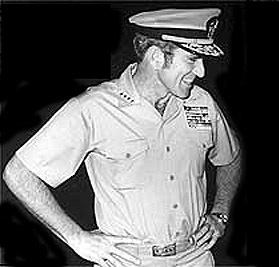
American involvement in Vietnam began with providing advisors for 2 years. Through the administration of five U.S. Presidents and 10 years of intervention in the region, U.S. military roles expanded to meet the mounting challenges. Thus, U.S support as a process slowly transitioned from merely providing general war-time assistance to ever more comprehensive avenues of support to the Republic of Vietnam. Although our assistance began with sending a few advisors, even this initial commitment increased to approximately 16,000 advisors that included U.S. military instructors to train South Vietnamese Army ground-combat troops; U.S. Army and Marine Special Forces to foster development of South Vietnam's own Special Force units; U.S. Air Force aircraft, aviation pilots, and aviation instructors to instruct new South Vietnamese aviation pilot-candidates; and the necessary U.S. personnel to provide guidance and leadership to the South Vietnamese to develop their own fleet-air Navy.
Notable in this process is the fact that it was no small matter adapting and transitioning a primarily agrarian culture to a modern world-view. Practicalities began with the most fundamental of education since many of the South Vietnamese (and those who fled South from the communists) were illiterate -- unable to read or write in their own language. The next step focused on developing basic military order and discipline within these developing troops. This was followed by practical training in military practices such as effectively overcoming personal fears, emotional and psychological strengthening, standardized ethical conduct, as well as strategic and tactical planning. As the process continued, this base-line training was followed by providing instruction and practice in initial and advanced skillsets for combat using U.S. military equipment, weapons, and supplies. Admist each step leadership training was equally taught as a vital component, and opportunities were routinely provided for leadership development and practice.
As Commander of Naval Forces in Vietnam,
Admiral Zumwalt defined the roles of the Navy, assessed Navy personnel needs, and determined logistical support required to
achieve the objectives.
Additional formidable challenges were posed in the process of U.S. assistance to foster development of the Republic of Vietnam's own professional military units since Vietnam had been occupied for centuries, and the lives of most Vietnamese people had tyically focused upon activities associated with subsistence farming using water baffalo and oxen for planting rice, harvesting rice and fruits by hand, coupled with limited fishing to support their own families. The most significant exposure to the larger world experienced by the vast majority of South Vietnamese people was the periodic exchange of their extra goods at the nearest local market where they were likely to arrive via small, slender, family-made traditional wood boats. This unchanged rural indigenous lifestyle was anchored in an extended family atmosphere -- as they clustered together beneath thatched huts for generations without electricity nor modern conveniences.
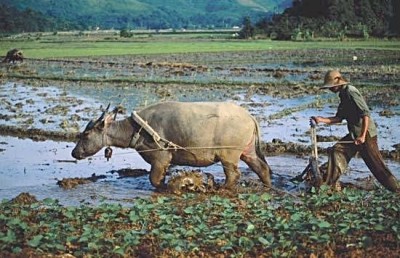


VIETNAM'S LIMITED UNDERSTANDING OF DEMOCRACY. Greatly complicating the smooth transition of the Republic of Vietnam into a democracy were the factors that the political perspectives of Vietnam's general population, its local chiefs, and its rising political leaders were based on centuries of domination (often in corruption or biased for self-absorbed interests) by other countries; therefore, the region's comprehension of democracy was very limited. Without a prior healthy and good model demonstrating a balance of human rights, values based on fairness, a judicial system, as well as an understanding of personal and government responsibilities the task of emulating these qualities provided by the U.S. proved even harder. Yet many of the Vietnamese people and their leaders had reached a point of desiring and seeking independence, even though their concept of independence was frought with trail-and-error as well as lessons-learned. As a consequence of the unanticipated length of time that it required to assist The Republic of Vietnam to cultivate and adopt the ways and practices of democracy -- coupled with the ineffectiveness of a succession of its political leaders -- U.S. White House policy-decisions shifted from a support/training mode to a direct action mode to expedite the process.
U.S. Military Interventions in Vietnam Provide Specific Successes:
Yet Major Factors Degrade Overall U.S. Effectiveness
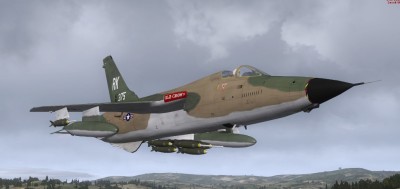
Based on the extended amount of time required to appropriately train indiginous troops of the Republic of Vietnam, U.S. President's Johnson and Nixon contributed major air bombing offensives to the effort that committed U.S. Air Force, U.S. Marine, and U.S. Naval air and fleet operations. These American aircrews took direct responsibility for the tasks of engaging and neutralizing targets, transporting troops, providing medevac care, refueling aircraft, and efforts that prevented the logistial and resupply of materials and troops to North Vietnamese and Viet Cong communist insurgents. These air, land, and sea efforts -- identified as Operation Rolling Thunder and Operations Linebacker I and II -- were sporatic over years. These operations were micromanged by the White House rather than sustained to a point of military success; and this micromanagement greatly diminished their effectiveness.
USAF F-105 Thunderchiefs were a workhorse, with over 20,000 raids in the Vietnam war, and especially adept at neutralizing surface-to-air missile sites.
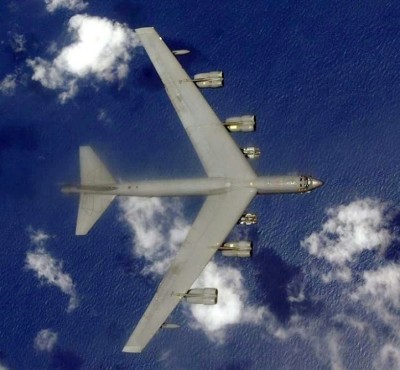
The outcomes of these specific operations were mixed since pilots successfully achieved their objectives and neutralized or destroyed all their targets. This was a joint-effort of fighter/bombers piloted by U.S. Navy, Marine, and Air Force crews and supplemented by Army helicopter crews as well. Each provided distinctly different strengths, capabilities, and missions. However, the North Vietnamese had ample time in between bombing-runs to rebuild, re-route, and even be fully prepared using sophisticated surface-to-air missile launches and mobile artillary in response to the next predicatable resumption of bombings that were authorized by the U.S. White House. U.S. forces were tightly constrained to a narrow corridor of time and airspace by specific Presiential decisions that personally determined every target, date of operation, time, and even further micromanaged every detail. This micromanagement from afar -- not by seasoned and informed military leaders but by Presidents Johnson and Nixon -- resulted in over 1,100 aircraft shot down or destoroyed during these operations. The human cost of these specific air operations alone (not including life lost during close-air support to ground troops) resulted in 382 American aircrew dead. An additional 702 aircrew (primarily pilots) were Missing in Action -- most of whom were shot down and became Prisoners of War or later confirmed as dead.
You
The all-weather USAF B-52 Stratofortress has a history of prompting adversaries to return to negotiations.
MAJOR U.S. AIR BOMBINGS SUCCESSFULLY NEUTRALIZED NORTH VIETNAMESE TARGETS; YET COMMUNIST TROOP MORALE REMAINED AT A HIGH. Although the air bombing-runs successfully destroyed North Vietnamese military bases as well as airfields, key infrastructures, ammunition and oil storage areas, transportation centers, bridges, and war-related factories, their overall effectiveness was diminished by several additional realities. First, in spite of the physical damage to the war-making components of North Vietnam, morale of North Vietnamese communists remained surprisingly high. In large part this was due to the structure of the Communist Party that maintains separation and co-authority shared in the field between military field commanders and "political commissars.". Political commissars were embedded within each battalion and served in a role similar to a morale coach, a chaplain, and a social worker. They were direct representatives of the Communist Party and were hand-selected for their revolutionary orientation and unwavering allegiance to the Party. Before every military operation Party commissars clearly outlined the goals, accomplishments, and plans; and in a like manner they were able to rouse the spirits of troops, provide resources to uplift troop unity/recovery/resilience, as well as reinforce troop cultural identity and values. In addition to these efforts that supported general morale of their military perssonnel as a whole, commissars were also responsible for providing very individualized support to any soldier experiencing hardships. This distinct delineation and co-sharing of power between the commissars and military senior leaders was performed in strict accordance with Marxist-Leninst protocols (based on an inherent distrust by Communist Party leaders of military power and any potential coups).
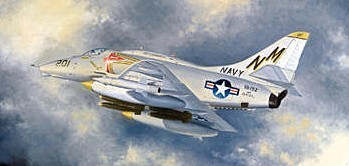
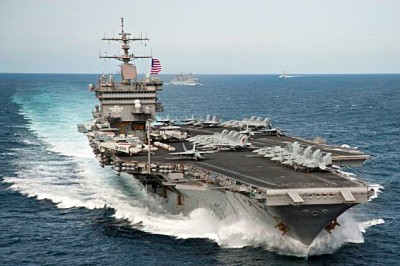
USN & USMC A-4 Skyhawk fighter/bombers launched from carrier platforms provided legendary assets based on their speed, power, versitility, and ability to own the air space. They exccelled in air-to-air dogfights, delivery of diverse payloads, air-to-ground attack, as well as close air support to protect U.S. and coalition troops.
COMMUNISTS WERE PREPARED FOR THE LONG-TERM EFFORT REQUIRED TO CONQUER SOUTH VIETNAM. Additional factors contributing to why U.S. efforts were ineffective in Vietnam became evident at the end of the war since communists were committed to achieve their goals of transforming all of Vietnam into a unified communist nation as a long-range goal, not merely a short-term objective. Therefore, they were fully prepared for slow, steady progress, and were fully oriented to accomplish their objective however long that would take. During discussions by U.S. leaders with North Vietnamese leaders at the conclusion of U.S. interventions, Vietnamese leaders smugly underscored their objective was merely to prolong the war through any and every means, knowing that ultimately the United States would go home (as other countries had done) and withdraw much if not all its support to South Vietnam.
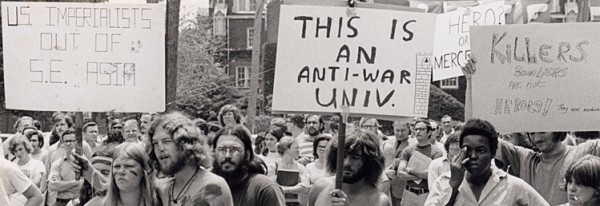
COMMUNIST TROOPS RECEIVE SUPPORTS FROM NORTH VIETNAM, THE SOVIETS, AND CHINA WHILE U.S. MILITARY PERSONNEL ARE DEGRADED & REVILED BY AMERICAN PUBLIC. As U.S. intervention expanded to include escalations of ground-level troops deployed to Vietnam, the conflicts displayed on American streets worsened. Communist troops received morale boosts and psychologial support continuously in their duty assignments not only in their combat units but also through numerous channels of the North Vietnamese communist government. Additionally, they were regularly honored for their efforts as major contributions toward fulfilling the goals of the Communist Party mission by both the Soviet and Chinese governments.
As U.S. intervention expanded to include escalations of ground-level troops deployed to Vietnam, the conflicts displayed on American streets worsened. Instead of even offering basic respect to U.S. military personnel for their sacrifices, U.S. men and women in uniform were routinely regarded as mere murderous cogs in "the military industrial complex" by demonstrators and protestors back home; and the American public frequently openly reviled U.S. military personnel. Furthermore, even their civilian counterparts in civil-government roles -- who provided intelligence operations, humanitarian aid, and diplomacy -- met with a similar fate by the anti-war/anti-government/anti-establishment sentiment displayed in communities and at universities. As a consequence those who performed their duty to their nation and endured countless sacrifices on behalf of U.S. citizens -- and who likewise sacrificed to support the goals of freedom for the South Vietnamese citizens -- received little support (and inadequate budget for their missions) from either the U.S. Presidents or U.S. Congress/Senate during most of the Vietnam War.
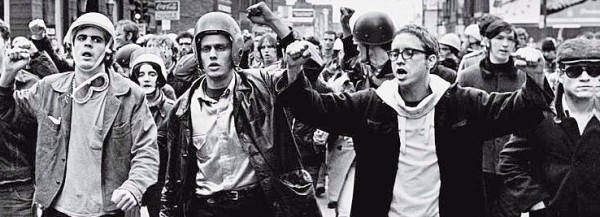
Chants and placards often reviled U.S. military personnel during the Vietnam War -- calling them "killers," "imperialists," "murderers," "baby killers," and "losers." Upon their return home, men and women in uniform were frequently met (individually and collectiely) with jeers or those who spat in their face.
As only one of many incidents, when Navy aircraft carrier U.S.S. Nimitize entered port, large crowds of protestors awaited atop the San Francisco-Oakland Bay Bridge. In accord with Navy traditions, sailors stood formally shoulder-to-shoulder in their dress white uniforms at the ships rail, excited to be home. However, their "welcome home" consisted of protestors dumping buckets of urine and feces on them as the ship passed beneath the bridge.
U.S. Veterans Affairs clinical research reveals that the highest rate of post traumatic stress occurred for military personnel serving in the Vietnam War era compared to other war eras. The lack of public support for military personnel during the Vietnam era and for veterans of this era took its toll during the war and for decades thereafter. The lack of support (from the government, universities, employiers, community, and families) greatly reduced opportunities for individuals to be appreciated for their sacrifices, adjust, heal, rebuild resilience, and usher in a smooth transition and reintegration back into civilian life. Equally notable is the fact the suicide rate of Vietnam Era veterans remains astronomically high (for the same reasons) in comparison with other wars in which Americans have served.
Two U.S. Presidents Disregard Miliary Expertise and Seasoned Experience
PRESIDENT LYNDON JOHNSON INHERITS A WAR HE NEVER WANTED AND REJECTS ANALYSIS BY MILITARY EXPERTS. After the tragic assassination of President Kennedy, Vice President Johnson assumed the mantle of Executive Leadership of the nation, and freely stated this was a war he never wished to be engaged in. However, in spite of this fact, he chose to micro-manage the war due to complications of the Cold War with the Soviets. Vietnam was deeply negatively impacted by White House decisions that tightly restrained military efforts due to fear of how the Soviets and China might respond. President Johnson's assumptions were that if the American effort was perceived as "too aggressive" by foreign adversaries in Vietnam, then nuclear war might evolve as an impulsive response from either North Vietnam, the Soviets, or China. Although that perspective has merit, actual war-time analysis by U.S. military advisors, analysis by independent well-esteemed U.S. "think tanks," and perspectives of many in the Congress and Senate were not sought, valued, nor considered by President Johnson. Instead, personal assumptions prevailed. What appears evident from historical documentation is that these assumptions and this view served merely as a smokescreen and excuse for a lack of developing effective Executive policies as they related to the Vietnam War effort.
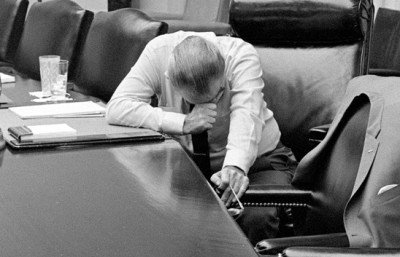
President Johnson became increasingly stressed over the Vietnam War, and equally depressed that the war was taking so much of his time and focus away from The Great Society he wished to create as his contribution and legacy during his administration.
President Johnson had envisioned that his primary attention during his administration would focus on domestic issues and his earnest intention to create "The Great Society." However, he inherited the Vietnam War; and his cabinet members and Pentagon advisors record that he frequently displayed frustration, anger, and resentment that the war was overshadowing his time and focus in office, as well as became the focus of the American public. Consequently, others close to him also note, his attention was not on the war to the degree that would have been beneficial, but instead continued to pursue his own interests for what he desired "his legacy" to be. As his administration was nearing its conclusion, the Paris peace talks finally were coming to an agreement; and Johnson believed if this could be achieved, his re-election would have a higher chance of succeeding and he would then have the opportunity to invest much more time, energy, and the American public's attention to expand his programs for a "Great Society." With the anticipated signing of the peace agreement, plans were also established to withdraw all Ameraican troops from South Vietnam in 60 days.
PRESIDENT JOHNSON'S
GREAT SOCIETY PROGRAMS
Sweeping legislative policies enacted in Johnson's Presidential term:
Establishment of Medicare and Medicaid; reduced poverty; increased opportunities & programs for the poor; outlawed racial discrimination; strengthened racial civil rights; added Federal wilderness areas, supported public educational television and radio broadcasting; and supported creation of model mass transit programs,
PRESIDENT NIXON'S SELF-ABSORPTION, DISTRUST, AND THE DEADLY DANGER OF HIS INSULATED VIEWS. As both a Presidential candidate and as serving as President, President Johnson's successor, Richard Nixon, did place considerable attention on the war. However, he regarded the war from the viewpoint of how it could benefit him personally. His decisions were based upon an unbalanced approach to "win the war" focused entirely on short-term objectives that related directly to applying this perception of winning the war under his leadership to achieve his first election and his subsequent re-election. As evidence, confirmed by White House tape recordings (and documentation by his Chief of Staff, H.R. Halderman), Richard Nixon sought out and created a secret "back door channel" to communicate with the Republic of South Vietnam's President Nguyen van Thieu through his aide Anna Chennault, a pro-nationalist Chinese lobbyist. By this interference during the Presidential campaign against President Johnson Presidential candidate Nixon sabotaged the Paris Peace talks -- where a peace agreement was impending and anticipated prior to the election. In fact, all appearances were that the war would end before the election; and U.S. troops would return home by the election. However, through the back-door channel directly to President Thieu, Nixon communicated through Ms. Chennault that he strongly believed he would win the election and he convinced President Thieu not to accept the peace agreement since he assured Thieu that he would give him a better deal when he assumed the Presidency. After carefully considering this offer, President Thieu chose not to attend the peace conference meeting, and therefore the peace agreement was not signed and this opportunity to end the war failed.
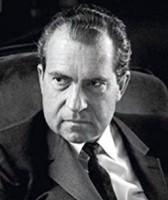
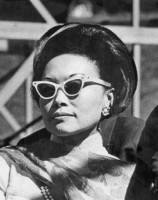
During the election campaign process during President Johnson's administration, Richard Nixon secretly creates a "back channel" to the President of the Republic of South Vietnam through Anna Chennault -- a nationalist-Chinese-lobbiest -- in order to thwart the Vietnam War peace process. Nixon's election strategy was dependent upon him ending the war, not Johnson; and he successfully sabotaged the impending peace agreement.
Compared to criminal charges that President Nixon later faced regarding Watergate, these actions of "the Nixon-Chennault Affair" were clear grounds for treason and would have been punishable as acts of treason. However, these facts were known by few, and only came available to American public decades after the impeachment hearings of the President and his subsequent resignation. Although Richard Nixon had the experience, intellect, and drive that could lead to a highly successful Presidential legacy, his penchant for criminal behaviors outweighed and consummed both his Presidential terms in office. Furthermore, what is known now from the historical perspective is that his strategies, tactics, behaviors, choices, and actions illustrate a complete disregard for life by extending the war by many years -- a tragedy that impacted millions of military personnel and the Vietnamese people very personally, as well as inflicted countless sufferings on the communities and families involved.
If the U.S. Congress & Senate had known that Nixon sabotaged the Vietnam peace talks, this evidence would be clear grounds for treason. However, these facts were not revealed until decades later through tape recordings and direct documentation by H.R. Haldeman (Nixon's White House Chief of Staff) that were discoverd in the Johnson and Nixon Libraries.
XXXXXXuring President Nixon's administrations, the Congressional hearings revealed that instead of choosing what beneficial for the U.S. as a nation and decisions that would have supported democracy as a whole in the world. Furthermore, neither of these two Presidents chose to fulfil U.S. commitments to support the Republic of South Vietnam as a democratic nation in such a way as to be successful. Instead, they utilized the position and respnsibilities of the leadership of the free world for their own personal self-serving intentions. LEADERSHIP decisions that related to tHE WAR, as well as foreign and domestic policy based on self-absorbed self-benefit. XXXX
The frustration of Admiral Zumwalt and other U.S. military leaders during this period reflected their understanding of the legitimate opportunities to end the war through a combination of both military and diplomatic means. Those in these leadership positions noted that numberous opportunities arose that could have legimately ended the war and reduced the loss of life on all sides. Additionally, military leaders were further frustrated since they had a good working relationship with both President Thieu and those of his government in addtion to equally good relationships with the various military branches of the Republic of Vietnam -- military units that the U.S. had professionally trained and that they had seen had witnessed as more capable of providing a greater degree of their own nation's safety and security. Admiral Zumwalt was therefore among those who were fully committed to provide training to the Republic of Vietnam within a peaceful but stabilizing structure that would permit that nation to engage in free elections and support their country's transition into a more stable democratic atmosphere.

White House Policies Fail to Defend Against Foreign Adversary Interference in the United States:
Communist-Socialist-Terrorist Influences Fuel U.S. Social Strife
COMMUNIST LEADERS OF NORTH VIETNAM, U.S.S.R, AND CHINA EXPLOITED U.S. SOCIAL STRIFE TO SUPPORT THEIR OWN AGENDAS. The intense social and ideological strife during the era of the Vietnam War created the foundation that the Communist Party historically seeks and found in the United States as fertile ground not only to seed their perspectives and propaganda, but also to inspire willing recruits through diverse doors. Historically, communist leaders target existing social rifts rather than initiate those rifts; and they found a wide spectrum of opportunities to engage in with various social groups and over a continuous period during the 1960s and 1970s. Therefore, their leadership concentrated on increasing discord through carefully crafted psychological warfare combined with public events designed to attract the media. Professional paid Communist Party agitators and communist/socialist sympathizes historically are enlisted by communist leaders to exacerbate social discord and division through orchestrated "street theater." Such "theater" provides the public attention they seek to increase support to their cause. The Vietnam War era proved to be a very rewarding period for communist efforts in the United States; and their leadership was highly successful in exascerbating the chaos that has traditionally formed the basis for violent revolutuions that have in fact sometimes successfully overthrown existing governments.
The environment within the United States at the time was one of tremendous division between races, cultures, ethnic traditions, political party agendas, philosophical ideals, religious differeneces, sexual preferences, age-generation divides, and even gender issues. Likewise, there was a home-front battlefield among the Amerian public between three distinct major segments within the population: One segment was comprised of an extreme segment of the populace that included communists, communist-socialist sympathizers, anti-war/anti-government/anti-authority/anti-establishment and counter-culture components; another segment was comprised of those who were centrists and moderates and who therefore supported social change within the structure of Constitutional Law and order; and the third segment consisted of those who staunchly advocated for a conservative law and order governing framework as a response to the chaos in the streets. The prevelance of illicit drug use by a significant portion of Americans during this time-frame -- including frequent or addictive use of marijuana, cocaine, heroin, and mind-altering psychodelic drugs such as LSD -- deeply influenced both perceptions and actions. Consequently, such drug use further fueled disagreements, devisiveness, and often spawned group/mob rage and violence. It was a time of extremes, where leaders of many groups encouraged and incited violence as a strategic means to initiate the social revolution they envisioned; and their concpets, rhetoric, and actions idealized and romaticized violence by which they believed they would bring about their own ultimate power and contol over others. In large part, the leaders of many of these social movements had strong allegiences to the Marxist-Leninist Communist agendas of either Mao or Stalin as their preference, and they expressed it openly in their rhetoric, documented propaganda, as well as in demonstations and organized protests.
During the Vietnam War, Students for a Democratic Society -- originating from a merger of the League for Industrial Democracy (a Socialist organization) and the Communist National Student League -- became a central force and instrumental in providing what became known as "teach-ins" to spread their philosophy across university campuses in the United States. It was this organization more than any other at the time that engaged in effective demonstrations to garner public support, media attention, and a growing membership to adopt their methods and mission. The SDS attracted many individuals who supported a variety of causes via their "teach-ins" (which provided propaganda/communications to upwards of 20,000 and even 36,000 university students at a time), and thereby provided effective instruction designed to entice and enlist new- comers to their Marist-Leninist political doctrines and objectives. The Weatlhermen -- a violent revolutioary faction of SDS -- ultimately superseded the initial leadership of SDS and took the initiative to bring the varius chapters together from across the U.S. and likewise brought together many of the social change groups (such as Black Panthers) under one ideiological umbrella. The Weathermen (later renamed Weather Underground) were focused on action exclusively in the form of terrorist activities; and their members went "underground" to escape accountability from law enforcement, the courts, and prison for their frequent bombings which destroyed Federal and State properties, military and university facilities, and resulted in murdering and injuring innocent victims. Favorite targets of the Weather Underground were locations where U.S. military could be found -- the U.S. Navy Recruting Command and military enlistment processing centers; recruiting offices; military bases and air stations; military vehicles of recruiting personnel; the Pentagon; the State Department in Washington DC, ROTC facilities at campuses, and military research projects funded at universities. One circumstance that was a bomb designed to explode during a dance where 300 non-commissioned officers were gathering that night with their dates.
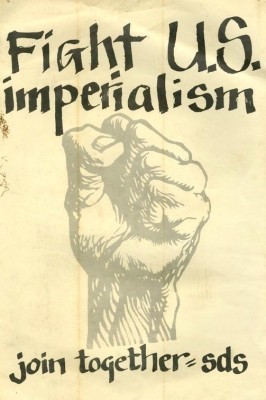
The leadership changes within Students for a Democratic Society vascilated in their core principles based in Marxist-Leninist political doctrines. Their political ideologies argued between strategies and tactics that would create a violent revolution in the United States via the philosophical and functional methodologies employed by Trotskyism, Stalinism, and Maoism.
Ultimately, the SDS re-branded itself through the leadership that became known as the Weathermen and the Weather Underground. This further transformed the organization into a purely violent revolutionary model dedicated exclusively to accomplishing their goals through terrorist activities.
The SDS and Weather Underground's own published communications boasted that their leaders met repeatedly with North Vietnamese, Soviet, and Chinese Communist Pary leaders as well as with Che Guevara (Communist revolutionaly guerrilla leader who successfully orchestrated violent revolutions in various global regions). These meetings are also confirmed by declassified FBI reports. The discussions in these hard-core communist environments in North Vietnam, U.S.S.R., and China are recorded as concentrating on strategies and tactics to employ in the United States in order to facilitate a violent revolution in America. Collectively, these leaders decided that the one common vehicle that would most likely lead to success to initiate a violent revolution on a scale capable of overthrowing American democracy and democratic institutions would be by spearheading opposition to the Vietnam War as their chief overall focalpoint. By this strategy they projected that they would be able to accomplish two missions: First, significantly influencing the outcome of the war in Vietnam so as to unite both North and South Vietnam under the complete authority of the Communist Party; and secondly to overthrow the U.S. democratic government and replace it with communism.
The SDS, Weathermen, and Weather Underground leadership adopted the same approach as that employed by North Vietnamese Communist leader, Ho Chi Mingh when deciding between ideological differences and Marxist-Lenist frame-works to overthrow an existing government. Wishing to alienate neither the Soviets or China, Ho Chi Mingh and SDS therefore embraced aspects of both political ideologies to ensure receipt of the benefis, money, resources, and support from the Soviets and China to fulfill all their own end-game objectives.
In the philsophy of the SDS and Weathermen, the end justififes the means; therefore through a carefully crafted process they transitioned a great many Americans through use of their slogans and methodologies toward the conviction that "power grows out of the barrel of a gun," and that the goals for their specific causes could only -- and would only -- meet with success through violence in the streets in a pitched battle between the people and the government. Specifically, their leaders violently opposed the war as it applied specifically to Vietnam and they likewise opposed the U.S. military objectives that focused on assisting the Republic of South Vietnam retain its sovernty as a democracy. This was contrasted with their objectives that encouraged and incited violence on the streets of the United States in their stated goal to overthrow U.S. governing institutions and democratic practices. Yet this philosophical conundrum did not deter the leaders of the SDS, Weathermen, nor many of the revolutionary leaders of social change groups from their intent to cultivate atmospheres of violence in order to achieve the utopia they portrayed in their propaganda. In fact, these leaders often cited the revolutionary effectiveness of these violent tactics in Communist China and the U.S.S.R to illustrate their success. However, what was not examined (nor encouraged to examine) at the time of these Chinese and Soviet revolutions or thereafter is that historical evidence reveals that governance by communist principles and practices has not led to these envisioned utopias; and instead such approaches have consistently led to increased suppression of human rights and considerable suffering among its societies.
The Vietnam War -- inclusive of American anti-war, anti-government sentiment -- evolved as the common thread by which communist-socialist leaders linked diverse social change groups in the United States into a larger context and network. In this process, merely a strategy to single out the war was not enough, nor was it enough to discredibt the U.S. government as a whole. Instead, devaluing and delegitimizing democratic institutions and Constitutional Laws also became a propaganda means of demeaning their worth and encouraging an overthrow of every symbol of authority. To personalize this even further, communist-socialist leaders and their sympathizers evaluated that they needed to put a face to the name and "crimes against the people," therefore they also focused on those who were engaged in the war itself, that is, U.S. military men and women -- who they targeted as perpetuators of the war and the soruce of Evil. This strategy -- devised by Che Guevara in combination with the North Vietnamese, Soviet, and Chinese leadership -- employed this as skillful psycholotical warfare. It proved successful in Communist propaganda in order to blame, degrade, invalidate, and, when possible, shame and humiliate military personnel -- individually and collectively. These same propaganda sources concentrated on painting U.S. military personnel as "losers" and "baby killers" in the eyes of the American public, and utilized every opportunity to create mis-information and dis-information of military successess or concerns into failures, disgraces, and "losses." An additional strategy empoyed by communist-socialist leaders in America at the time "weaponized" their membership by encouraging individuals drafted into U.S. military service to engage in these same discrediting practices from within to disrupt military actions in every way possible from inside the institutional structure. In this way, U.S. military personnel also became scapegoats for the White House policies (and lack of policies) that created and sustained the Vietnam War. Furthermore, with the horrors of war televisioned on the evening news every night as well as in docoumenaries, the American public saw for the first time what war looks like in real-time; and Socialist-Communist leaders encouraged and inspired social groups to focus on this opportunity to use the nation's attention for their own social cause and benefit TO END U.S. SUPPORT TO SOUTH VIETNAMESE AND EASY RESPONSE
The beliefs and dogma of the SDS, the Weathermen, and each of the diverse social change groups that advocated for violent overthrow of the "establishment" significantly influenced the American pubic's view of not only the war but also of those who served in it. Such chaos and division in the streets -- reported daily in the news across the nation -- became a focalpoint for "change" in every aspect of American life. Consequently, this backdrop became the last thing American military enlistees saw on their way to serving in Vietnam and was the same or similar (and in many cases worse) scenario to which they personally returned where they themselves became a scapegoat for failed policies of the U.S. Executive and Legislative processes. Furthermore, in large part, Congression/Senatorial response at the time was one of inertia or parallysis -- where they exhibited a resistence to creating legislation in an apparent fear of voter retaliation in their next elections.
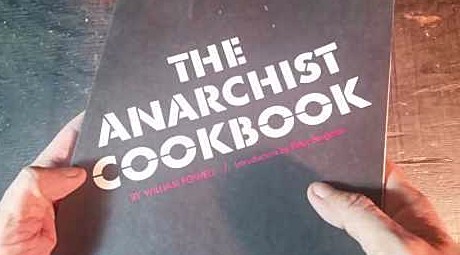
Exploiting the tensions within America even more, the Anarchist movement arose in America during the Vietnam War. This movement targeted America's youth as recruits (where anyone over 30 was the enemy) and encouraged them to cast aside all "traditional" political ideologies. Instead they romanticized and promoted complete "freedom" that they defined as destruction of all forms and sources of authority. Their propaganda promotes the concept that to achieve "true independence" they must destroy any ability for oversight, accountability, or consequences for personal choices. As a philosophy, the Anarchist movement endorses a complete lack of pro-social conduct or society responsibilities. Instead, the Anarchist Credo focuses on direct ACTION, and boasts of its capacity to destroy any form of law and order in order to perpetuate the chaos -- founded upon terorism -- that is its cornerstone.

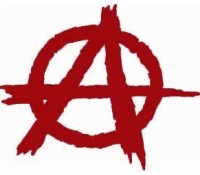
In addtion to fomenting social strife intended to spark a violent revolution by the people, the collaborative efforts -- of communist leaders and communist sympathizes, their splinter-groups under their umbrella, in addition to those engaged in the Anarchist movmement --sharply focused their efforts on discrediting U.S. government agencies, democratic institutions, and the U.S. military itself. Anti-war anti-establishment sentiments and the discord among so many groups (that were united in some aspects and yet were conflicting among themselves in other aspects) created violent confrontations that spilled out routinely onto American streets not only in major cities but across the entire spectrum of the American landscape. These conflicts ultimately resulted in President Johnson resigning from the U.S. Presidency, and Richard Nixon was voted in as President on a platform of ending the war coupled with a law and order platform.
The
Anarchist Cookbook was widely distributed through mainstream bookstores and at universities during the Vietnam War era. It was not only "the bible" of those who formed the Anarchist movement but also of communist sympathizers and those of the American counter-culture. The "cookbook" provided not only a philosophigal framework but also specific guidance for direct action through the engagement of criminal acts. This included the manufacture of illicit drugs and drug-trafficing for project funding purposes; extensive descriptions and use of weapons; and detailed instructions for manuafcturing bombs and an array of other explosive devises for the purposes of creating and perpetuating terrorism.
ADMIRAL ZUMWALT'S CONTRIBUTION WITHIN THE U.S. SYSTEM OF GOVERNMENT AND THE CONTEXT OF THE REALITIES OF THE TIME. During this historical time-frame Admiral Zumwalt held increasingly higher and more comprehensive responsibilities as the Commander of Naval Forces in Vietnam followed by promotion to the position of Chief of Naval Opeations (the highest Navy leadership position) and serving as one of the Presidential Military Joint Chiefs of Staff. Given the dissent that presented itself not only in American society but also affecting individuals within the military, the Admiral chose wisely to work with the realities that existed rather than ignoring, denying, or opposing them. He based his decisions on four key responsibilities: First, employment of the powers granted to him in both a personal and professional way that best support and embody American core principles and values. Second, safeguarding American citizens and America's democratic processes, Constitutional Law, and institutions. Third, contributing to U.S. efforts to assist the Republic of South Vietnam to remain independent as a democractic nation and contribute toward facilitating that country's stability. Fourth, improving the structure and creating policies of the U.S. Navy by no less than total transformation of it as a vehicle for positive change -- as an inclusive, fair, American institution composed of the highest quality professionals.
White House Dereliction of Duty:
Lack of Guiding Policy & Strategy in Response to Communist Threats
to Overthrow Democratic Governments
Although mililtary and diplomatic experts (at the time as well as after the war) cited several significant junctures where U.S. efforts could have realistically ended the Vietnam war and realistially brokered successful efforts for the freedom of South Vietnam (both in Peace Agreements and militarily), the decisions of the U.S. Excecutive and Legislative administration did not choose these options. Instead White House choices were made that continued on a path that extended the war. Not seizing the opportuniites presented created much frustration by miliatary leadership, lowered the morale of U.S. toops, and served as a detriment to the Republic of South Vietnam. Furthermore, the Congress/Senate chose not to employ its oversight and decison-making capabilities in these matters.
Foreign relations experts, political and presidential historians, political strategists, scholars, and senior esteemed military leaders provide their analysis based on comprehensive data collected from all sides after the war. Although the complexities of this war are well worth the study by anyone interested in war and peace, these subject-matter-experts conclude the fundamental basis of why the U.S. found itself in a quadmire was due to the fact that none of the five U.S. Commander-and-Chiefs had defined an overall guiding policy and strategy to effective respond to communist threats to overthrow democratic governments (including protection for the United States). As an outcome of this deficit to produce a guiding policy, U.S. presidents also failed to develop an exit strategy to the war in Vietnam until it became directly politically expedient and personally beneficial to themselves.
False Perceptions Contrast with Reality
From the highest Executive government level, the U.S. conducted its interventions in Vietnam based on "attrition," -- a simplistic body-count of enemy found dead as a statistic provided to the President rather than Presesidential consultation with its U.S. and coalition military experts in the region. For this reason Presidents Johnson and Nixon defined "victory" based on the numbers of the enemy dead in contrast to other measures that reflect success. Consequently, White House policy functioned from the assumtion that dessimating the North Vietnamese troops would directly translate to convincing the communists to give up the fight. For similar reasons, it was also believed that such a "victory" by numbers would also immediately "win" and maintain the independence of South Vietnam as a continuing Republic. This proved to be a very unrealistic and simplistic view. Instead, reality proved that even at the height of the Vietnam War -- when 20 North Vietnamese Army regulars and Viet Cong guerrillas died for every one American or South Vietnamese -- there remained a seemingly never-ending fresh supply of fervent communists (provided by China) into the fray.
With the White House administration still cliniging to false assumptions, disrupting and interfering with the supply chain that provided fresh troops and supplies to the North Vietnamese and Viet Cong guerillas became the next fixation by U.S. Presidents in order to reduce the military effectiveness of the communists. The primary access points for resupplying the communists within the South Vietnam region were through two sources. One primary source of supplies arrived via the coastline bordering both the Gulf of Tonkin and the South China Sea; and the second source was via the lengthy Ho Chi Minh Trail that connected the supply lines from North Vietnam. This trail winds through Laos and Cambodia and re-enters territories of South Vietnam at various key points near major military bases or cities.
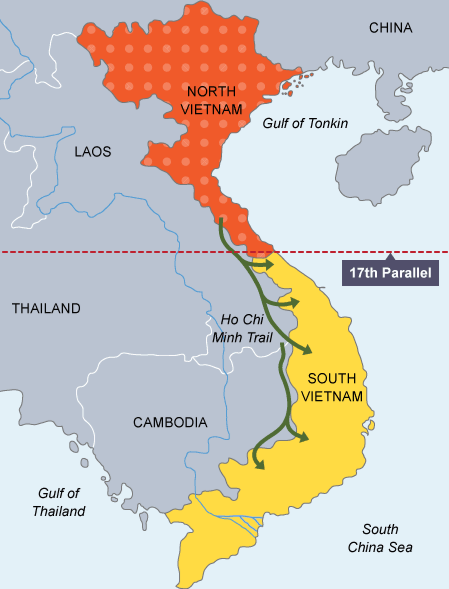
Russian & Chinese Communist support routes into
South Vietnam via the coastline and Ho Chi Minh Trail
Although United States military training, military equipment, and technological advances in each of the branches of military service were far superior to that of the communists, the U.S. was best prepared at the time for defense against missiles and nuclear threats (of the Soviets and China); and the North Vietnamese therefore fought with guerilla tactics as a successful countermeasure against the greater strength of their enemy. These realities were not truths that President Nixon wanted to hear from his military advisors, and therefore they were excluded by the President from most Presidential briefings and decision-making.
POLICY FAILURES: INACCURATE INFORMATION PROVIDED BY THE WHITE HOUSE TO THE CONGRESS/SENATE AND AMERICAN PUBLIC. As Commander of Naval Forces in Vietnam, Admiral Zumwalt and other key U.S. and coalition military leaders in the South East Asian region noted that initial U.S. preparation and continued engagement in the war in the same way was not effective nor advisable. Furthermore, in contrast to the inaccurate information provided by the White House to the American people daily, clearly U.S. forces were not provided with Executive policies and overall strategies to appropriately engage in assemetrical warfare rather than "conventional" warfare; and these inadequcies previously led (and continued to lead) to inability to engage in tactics that would likely be successful in contrast to engaging in tactics that continued to prove ineffectual. This lack of honesty, especially egregious by President Nixon, had the outcome of lack of budget approved for appropriate additional training for military personnel; misuse of military personnel; overspending on high-end "conventional" military products and services; and lack of basic equipment and supplies for what was actually needed by military forces.
GUERRILLA TACTICS IN AN ASSEMMETRICAL WAR. The North Vietnamese and Viet Cong guerrillas were highly successful in confusing the U.S. miltary personnel by embedding with the Vietnamese civilian population in villages and provinces. With Vietnam's long history of struggle against occupation (by China, then as a French colony, by Japan during World War II, then attempts to re-acquire it by the French again) the Communist Party had ample time to perfect their resistence efforts and develop highly effective guerilla tactics in their own homeland.
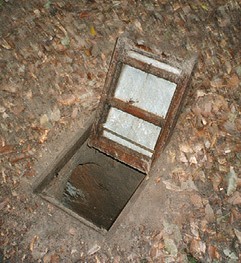
SECRET UNDERGROUND TUNNELS. As part of the military effort and expertise honed from the 1940s onward in war-time the North Vietnamese communists created a well-established secret underground tunnel network system running the full length of the country through north and south, and this also extended into regions of Laos and Cambodia (where for a time U.S. troops were not permitted). This tunnel system was often several levels in depth and provided all the major base-camp needs of troops coming together for rest and recovery, acquiring new orders, exchanging information through spy networks, and troop movements.
Communist troops remained in these tunnels through most of the day and more typically only came out at night to ambush their enemies in the jungles, marshes, deltas, as well as along the river and coastal water-ways that served as the primary transportation system of the Vietnamese populace. In addition to permitting access points from which to attack their enemies, these routes proved to be useful avenues for stealing food along these corridors. Although highly rustic circumstances, life underground for the communist troops provided considerable benefits. These included: Barracks and safe quarters for resting and sleeping; hidden protected sectors for cooking, hot meals, and eating without being detected by the enemy; plentiful food storage areas; confidential rooms that served as high-security meeting locations and combat command centers; interrogation areas as well as reserved rooms dedicated to sophisticated technological intelligence gathering; communications systems; rendezvous points for spies; weapons and ammunition caches; latrines; bathing areas; theaters for troop entertainment and morale boosting; and even clinical and surgical medical care areas. These underground facilities baffeled U.S. military personnel for years as U.S. soldiers and sailors would only see a fleeting image of a sniper who suddenly disappeared entirely and mysteriously within the jungle terrain or along the coastal waters. Even when a few tunnel entry points were discovered (in their carefully camoflaged states) their convoluted mazes, booby traps, deadly snakes tied or nailed to the interiors as guardians, and the trip wires for mines, granades, and release of sharpened bamboo punji sticks all were carefully designed to deter and maim intruders.
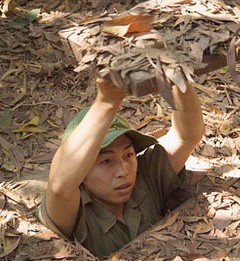

Although courageous U.S. Army specialists -- referred to as tunnel rats -- explored North Vietnamese tunnels with only a 45 caliber sidearm and a flashlight when military units could find entry points, the more frequent course of action for U.S. and South Vietnamese forces relied on either bombing tunnel entry/exit points that could be located or FIRE???? However, given the extensiveness of tunnels throughout Vietnam, these minor cave-ins that occurred by initiating these explosions by U.S. or South Vietnamese troops proved to be inconsequential as there were countless multiple connections, entries, and exits across South Vietnam, North Vietnam, as well as Cambodia, and Laos. As an example of the size and extensiveness of these tunnels they were so expansive that the populations of whole villages sometimes also hid in them when the shelling in their area became too intense. FIRE?
Camoflaged North Vietnamese underground tunnel systems extended throughout Vietnam.
Admiral Zumwalt Redefines & Restructures the Roles of the Navy in the Vietnam War
When Admiral Zumwalt took command over U.S. Naval Forces of Vietnam, the war was in a stalemate and U.S. mililtary morale (inclusive of that of Navy personnel) was at its lowest. There rarely seemed an opportunity to actually engage the enemy in any "conventional" war method where the superior training and technology of the United States excelled; whereas, the North Vietnamese strategy of maiming the enemy proved to be very effective in creating situations where Americans, coalition partners, and South Vietnamese Army personnel became preoccuped with extracting the injured rather than finding or fighting them. But with U.S. military leadership constrained in countless ways by the micromanagement directly by the White House, they were functioning as if they had "one hand tied behind their backs." It was Presidents Johnson and Nixon that determined target selection, units deployed, date of every operation, the precise locations where this would occur, timing during the day, and detailed actions engaged in. Therefore, Admiral Zumwalt concentrated not on what he and the U.S. Navy didn't have control over but instead what they did have control over within a very flawed circumstance.
NAVY HEALTHCARE AND HUMANITARIAN-AID ENHANCES COMMUNITY-BUILDING AND PROMOTES TRUST. The situation for the South Vietnamese people was a daunting one as it is for those affected directly by war in all such scenarios. Their country's history reflects periods of independence alternativing with conquest and acquisition that began with a thousand-year rule by China, then the French, Japanese, interests of the French again, and currently the agressive action by the communists sponsored and supported by the Soviets and China as reflected in the Vietnam War. Vietnam's militarily strategic location in the East, its raw materials in North Vietnam, and its agricultural richness in South Vietnam were -- and have been -- the attractions and the resources sought by others by violence. Working on behalf of a nation that suffered the ravages of war for generations, the U.S. found it difficult to develop and build local relationships with the people in order to faciliate trust and earn the "the hearts and minds" of a cautious segment of the South Vietnamese population. Further complicating the matter, the communists employed tactics based on intimidation, fear, and terrorism as constant reminders and evidence that each family member must comply with their orders and expectations. A standard practice of the communists focused on abducting young men for forced military service (even those as young as 12), and often included torture, rape, or murder one or all family members -- women, the elderly, the disabled, and children -- in order to coerce compliance. Villagers experienced occupiers from two sides and numerous countries; and although most South Vietnamese people understood the good intentions of the Americans and their coalition partners who were personally sacrificing to support their freedom and independence, ultimately their day-to-day ordinary lives and the lives of their family members were dependent upon finding a way to cope with the actions and consequences of their own actions and family loyalties. An inability to sometimes determine who was friend and who was foe proved to be equally challenging for U.S. military personnel, and for this reason dispensing U.S. Navy healthcare provided an avenue of community-building and alliance that clearly and effectively demonstrated genuine care, concern, and good intent by the United States for the South Vietnamese people.
As part of the community-building effort and humanitarian initiatives in South Vietnam, U.S. Navy nurses, physicians, hospital-corps personnel, and other U.S. Navy medical specialists and logistical personnel provided much needed daily medical services in isolated rural areas, local provinces, as well as in city hospitals of South Vietnam. Their fundamental but important tasks likewise included purifying water, controlling insect populations, and distributing nutritional food to refugees fleeing areas of conflict. The U.S. Department of Defense, the Department of State, and the U.S. Agency for International Development (USAID) partnered together to effectively fulfill these common objectives, and the Navy formed the back-bone of its effectivenss. Under Admiral Zumwalt's direction, the Navy provided the vast majority of healthcare personnel to Vietnam; and this included an extensive array of specialized medical providers as well as the organizational and logistical success of joint-operational efforts, an efficient structured process, the employment of air and sea emergency services to increase survivability, in addition to the air-sea supply transportation to ensure it remained a reality.
In addition to these multiple levels and models of healthcare, two large U.S. Navy hospital ships rotated from coastal points in the South to provide the best of medical specialists and cutting-edge medical technologies to war-torn areas. In doing so they served the needs of both military and civilian casualties that occurred not only from combat situations or disease but also by terrorism inflicted on the populations by the Viet Cong guerillas who indescriminately bombed the provincial open markets, bars, theaters and any location where they believed U.S. personnel or their sympathizes might be found. Additionally, these ships provided medical care to those who had been the victims of Viet Cong guerillas -- who erected booby traps throughout the jungle, delta, and coastal areas to impale individuals or trigger explosions by any unsuspecting passer-by -- be it military personnel, a villager taking extra goods to the market, or a child playing.
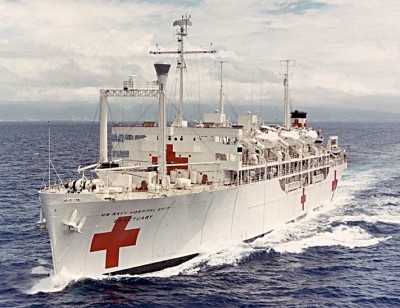
The medical personnel aboard U.S. hospital ships equally served U.S. military, our coalition partners, and the South Vietnamese population. These ships provided a safe location in the most ever-changing impacted areas for this treatment; and two helicopter pads on deck provided a means of transport and delivery of casualties that proved both rapid and highly efficient. These medical ship personnel served those suffering from wounds, injuries, malaria, internal parasites, leeches, dystentery and illnesses of every type, as well as controlled skin fungai and jungle rot. They also provided complex surgeries, preventive care, and innoculations for adults and children. For many of the South Vietnamese people, this American healthcare was the first healthcare they and their family members had ever received.

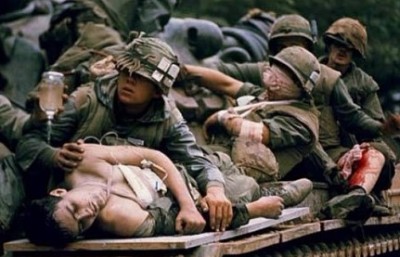
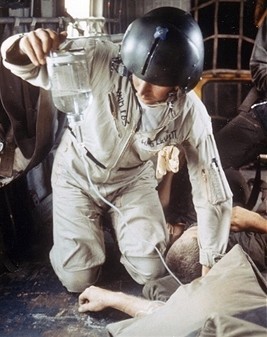
Many U.S. Navy medical personnel also served directly with Marine combat units throughout the jungles, deltas, and coastal regions, and they were fully immersed in the most hostile war conditions of Vietnam. As additional contributions, a significant portion of the Search and Rescue and medical helicopter (medevac) teams -- including their pilots -- were those of the Navy. In these roles they provided emergency medical services and transport under intense direct fire from the North Vietnamese and Viet Cong as they treated the wounded, injured, and sick of all U.S. and coalition military branches, South Vietnamese government partners, and the South Vietnamese civilian and refugee populations.
Being both a visionary and bold by nature, Admiral Zumwalt demonstrated his understooding of the complexities, conditions, and "the new reality." He further defined and developed other new ways of utilizing U.S. Navy forces. He relied heavily on the unique qualities and expanded capabilities and skill-sets that he ordered to be established in Navy SEALS; and he coupled this strategy with the innovative addition of the "Brown Water Navy" that was composed of swift-boats patroling the coasts, harbors, rivers, and estuaries of Vietnam (later also including Cambodia and Laos).
U.S. Navy's Elite SEAL Warriors Integrate Comprehensive Skill-Sets
World War II and the Korean War Navy maritime specialists included U.S. Navy "frogmen" in Underwater Demolition Teams. Their missions were concentrated on transporting explosives underwater to their targets (bridges, ships, etc.), setting the explosive charges, and ensuring their objectives were successful in order to eliminate key infrastructures of our war-time adversaries.
At the beginning of U.S. involvement in Vietnam, President John Kennedy (having served as a Commanding Officer of a Navy PT boat) established his vision that outlined the concept of creating a Special Forces component of the Navy. The training to meet that objective evolved as a gradual process transitioning members of the Underwater Demolition Team into the role of the SEALS that we know today. This new designation as SEALS referred to their advanced highly skilled capabilities not only in Sea, but also equally in Air and Land based operations. This training expanded to develop elite Navy warriors in unconventional warfare to better fit U.S. military needs in Vietnam and beyond.
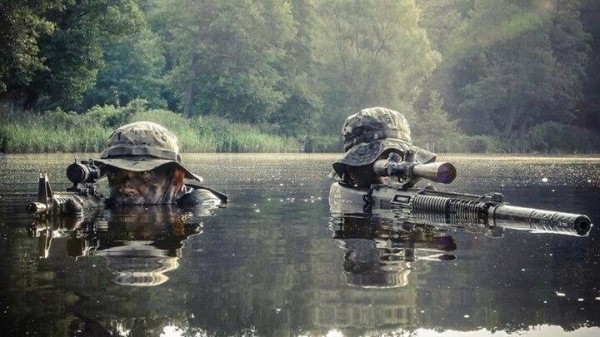
The intensive training of SEALS metamorphisized their units during the Vietnam War to become specialists not only on and in the water, but also in guerilla tactics thereby increasing their warfare flexiblity. They honed their skills in hand-to-hand combat, under-water operations, high-altitude parachuting, reconnasance, intelligence, clandestine operations, sniper expertise, language translation, as well as the "soft" social and communication skills necessary for negotiating and working effectively with diverse civilian populations and cultures. This vast array of comprehensive skill-sets that are requisite for every SEAL not only sets these individuals apart as an elite force within the Navy but also among other U.S. Special Operations teams. Special Ooperations units of each of the branches of service bring their own unique strengths and traditions. The Navy set encompasses an equal measure of these exceptional skills: High intellect; strong psychologaical resilience and fitness; the highest caliber of professionalism and proficiency in many specialties; creativity and innovation; out-of-the-box thinking; adaptability in every situation and terrain; confidence in extreme circumstances; close teamwork; selflessness; and courage.
Admiral Zumwalt employed SEAL team members to their full capabilities (and fostered training that even further enhanced these skill-sets). He realized their potential positive impact, and therefore he increased their numbers as well. One of the downfalls of U.S. combat forces in Vietnam up to that point had been U.S. intelligence-gathering which was all too often either missing entirely or highly inaccurate; and therefore, reconnaissance and intelligence gathering became initial focalpoints for SEALS for their own sensitive operations.
With their stealthy skills, accurate intelligence became a reality not only for their own operations but also for joint-operations that included all branches of U.S. forces as well as served as contributions to our other coalition members and the South Vietnamese forces. As part of this effort, SEALS proved their clandestine adeptness in rapid insertion and exiting from the jungles of Vietnam by water, helicopter, and swift boats in conditions and operations that were of extremely high risk and high priority. Often their duties were associated with high value targets, and rescue of our own.
You're not here
to survive this...
you're here to take charge of it
U.S. Navy SEALS Motto

Under Admiral Zumwalt's command SEALS functioned in small-units. These were typically composed of one officer, 6 enlisted specialists, and 2 South Vietnamese commandos. Their missions were exclusively of a highly classified nature; and they operated with considerable autonomy that frequently encompassed every aspect of their training.
Strategizing from a conviction that Navy personnel are the Navy's best and most critical asset, Admiral Z integrated holistic measures to reduce combat fatigue and supported mental fitness of not only Navy personnel in general but also for SEALS specifically. He accomplished this by deploying these SEAL warriors on a rotational basis on Temporary Additional Duty of approximately 6 month duration (with multiple deployments). Thus, even with these mentally tough warriors, Admiral Z was keenly aware of the toll that not only deployments have on individuals and families but also of the added toll (and need for balance) that occurs in the most continuous high pressure high risk environments. With these innovative approaches, SEALS became their own psychological weapon by reputation -- a warrior elite well known and feared by the North Vietnamese and Viet Cong communists.
U.S. Navy SEAL Credo:
The only easy day was yesterday
Admiral Zumwalt Initiates "Brown-Water Navy" Tactics
The U.S. "Brown Water Navy" tactics developed as a direct response to guirilla warfare, snipers, hit-and-run tactics by the jungle's edge, as well as in response to the booby traps, mines, and the extensive tunnel systems underground where the North Vietnamese Army and Viet Cong could disappear within moments.
The general mission of these 31-foot patrol boats was to create a blockade, limit major supply and troop movements, identify where the North Vietnamese and Viet Cong were traveling or entrenched, and maintain a safety zone for the South Vietnamese people to transport their food or move out from emerging combat zones. Generally skippered by one young college-educated junior officer and crewed by five enlisted specialists, each "Brown Water Navy" vessel additionally collaborated with the South Vietnamese and coalition forces to inject or extract Special Operations units in combat "hot spots." As additional responsibilities, they often moved U.S. supplies to different locatons and transported the wounded.
These efforts augmented more conventional operations that provided Naval vessels off-shore in surrounding areas to intercept incoming supplies and launch Naval air support to ground troops.

In the latter years of the war, U.S. White House decisions increased personnel in all branches of military service in surges. Therefore, these waterways became even more critical elements of American strategies and tactics in the war -- with small combat-seasoned crews aboard swift-boats serving in ever-expanding roles.
With a 75% chance of mortality or being severely injured while serving a one year deployment on a swift-boat, U.S. Navy crews patroling the waterways were at extremely high risk. Admiral Zumwalt searched for ways to lower the casualty rate of these Navy "Brown Water" river crews. After throughtfully weiging the challenges and options he employed the use of Agent Orange in order to eliminate the dense foliage within 1,000 yards of the riverbanks that otherwise hid awaiting snipers. His decision was based on documented assurances from all Department of Defense official reports in addition to research directly provided to him from the manufacturers of Agent Orange that this herbicide posed no harm to humans or animals, nor was it reported to pose permanent damage to the environment.

Transitioning to An All-Volunteer Military:
Admiral Zumwalt Employs His Role as Chief of Naval Operations to Create Posiitive Transformation
Given the research data, summaries, and conclusions provided from multiple sources, Admiral Zumwalt considered the use of Agent Orange as what he referred to as "the least worst decision" at the time (especially in comparison to the use of nuclear bombing frequently threatened by President Nixon). Admiral Zumwalt's decision to employ Agent Orange and remove the jungle foliage for 1,000 yards from the coastal regions proved to dramatically lower a sailor's liklihood of death or severe injury from 75% to 6%.

A critical juncture in U.S. Vietnam War plans focused on transitioning the combat roles in Vietnam to South Vietnam and ending the U.S. military draft. Ending the draft was designed to shift the responsibility for the military and political transfer to South Vietnam and therefore was a by-product of what was conceptualized by President Nixon as "Vietnamization" -- where South Vietnam would be capable of defending its citizens and its government. Although Admiral Zumwalt fully supported this concept and was engaged in this process with his South Vietnamese counterparts he was also aware of the realities that for the South Vietnamese defense forces to become professionals and capable of maintaining a stable environment would require a logical and planned transition for this to be effective. However, the Executive policies that would lead to this exist strategy weres not defined by the President.
But with the time-table being exclusively decided by President Nixon without input from the Secretary of Defense nor any of the military Joint Chiefs of Staff, Admiral Zumwalt also had responsibility for focusing on the Navy's transition into an all-volunteer force.
It was during this time-frame that Admiral Zumwalt was promoted to Chief of Naval Operations -- with the distinction as the youngest CNO in history at age 49. President Nixon selected him above 32 other more experienced Admirals based on his visionary concepts that concentrated on a plan for addressing the serious personnnel retention problem within the Navy.
Based on his prior Pentagon assignments serving within the Defense Department, Admiral Zumwalt had acquired extensive knowledge of foreign relations and maintained a big-picture view of the Navy and its roles; however, he also had a deep concern for the dwindling number of re-enlistments of highly valuable well-trained personnel who served the Navy as career professionals. In the Admiral's view, it was the individual Navy man and woman who made the Navy what it is, and he intended to create the environment within the Navy where they could fulfill their potential and become the best version of themselves.
Admiral Zumwalt offered his streategic plan to the President that reframed and redefined Navy personnel goals. This encompassed (but was not limited to) reducing the time of deployments, new policies to enhance and strengthen Navy family life, new policies that defined the relationships between enlisted and officer personnel, and methods by which to institute changes that reflect a deep appreciation of each and every member of the U.S. Navy community. In short, the CNO introduced the strategies employed later by the most successful U.S. corporations and applied them to the needs of the Navy.
VISIONARY
AND
TRANSFORMATIONAL
LEADERSHIP
Professionalism and High Technology Form the Backbone of The New Navy
Navy xxxx traditions technology; and because of that, on highly technical nature. For this reason the qualifications for entry into most of its professional specialties are high; and as a result, fewer individuals were -- and are -- selected for admission to the Navy. This was as true in Vietnam War era as it is today. Due to the military draft, some individuals during the Vietnam War were attracted to serve in the Navy who might not have otherwise been attracted to the degree of commitment that is truly required; so in their effort to avoid the draft they joined the Navy. In some relatively rare instances, this contributed to a degree of discipline problems and a reduction in "good order," although not to the extent that it appeared in some of the other U.S. military branches of service during this period in American history; and fortunately, it occurred at the end of the war instead of throughout the war. However, any reduction in "good order" immediately converts into diminished readiness, diminished effectiveness, and the increased possibility -- if not probabililty -- of not accomplishing the mission. Equally important, any reduction in "good order" also immediately contributes to an outcome of an increasing number of deaths of one's colleagues as well as contributs to deaths to innocents due to inattention, lack of internal motivation, dimensished mental capacity, lower emotional tolerance, or lower ethical standards. Thus, this was a fundamental reason why Admiral Zumwalt fully supported the ending of the military draft (as did the other military Joint Chiefs of Staff for the same reasons).
You c
The unique role of the Navy compliments the unique strengths brought by the Air Force, Marines, Army, Coast Guard, and Merchant Marines. The Navy's broad-scope role is to be flexible and arrive where needed and bringing what is needed. Additionally, it serves as an independent moving platform and poses its own deterent to enemy forces -- embodying not only its own detererence in regions and "persuasive" powers, but also offering its own strengths as a compliment to any mission through its highly trained and highly skilled crews. It would also be a truth to say that each individual in every position (and in each branch of service) has a very significant role to play in order to support comprehensive U.S. efforts, contribute to stability in the world, increase our own U.S. national security, and in this situation -- support the intended and declared mission of our interventions in Vietnam. In this war-time situation, this effort supported an ally and the desperate struggle by the people of the Republic of South Vietnam to retain their freedom and independence. Freedom and independence are concepts and traditions that most Americans cherish and hold dear; and that specific core value and understanding provided a consciousness by many individuals who enlisted in the Navy during the Vietnam War who pereived the plight of South Vietnam's people and their earnest desire for the benefits of democracy.


When exposed to hostile environments, it is understandably that the human mind naturally narrows and becomes intensely fixated on immediate issues -- where survival, and even more importantly, the care and concern for one's colleagues and friends in such events becomes the priority. By eliminating the military draft, assurances increased that the Navy could and would attract individuals functioning from the highest standards that naturally exhibit a higher consciouosness to see beyond the immediate situations and consider also the broader, more complex, and comprehensive picture.
Admiral Zumwalt therefore established a new criteria. He began by establishing a new criteria for selecting those who serve in Recruiting based on individuals who demonstrated the very ideals he identified that the Navy will be seeking to fill its positions -- those who demonostrate the highest standards. different qualifications who would form the structure of the Navy's new recruiting process; and their mission was focused to attract individuals who exhibit the highest levels of commitment, courage, ideals, leadership, and ethics that would form the backbone of The New Navy -- a New Navy dedicated to cultivate professionals and making decisons from the highest standards of professionalism.
Admiral Zumwalt welcomed the end of the military draft as an opportunity to "tighten" the standards for entrance to the Navy, raise standards of professionalism and ethics even higher, and cultivate career Navy professionals who embody the highest character and conduct.
A new Recruiting Command was created with the mision of attracting the best and the brightest through the Navy's reformed policies and inclusion. Recruiting professionals engaged in advertising, integrating with communities, and creating recuriting films to attract subject-mattr-experts.
Admiral Zumwalt conveyed a great appreciation for education. He held a strong conviction that education (before, during, and after military service) contributes to the highest caliber of not only intellect but more importantly of the development of consciousness and character. True to his nature, his out of the box thinking and vision challenges the tradition that emphasized direct operational service at the expense of acquiring increased levels of education. Therefore, he perceived that ending the military draft also created an opportunity to attract -- and even further develop -- the highest professional level and highest caliber of individuals needed by the Navy for the technological advances of the present and future. He also forsaw that these same individuals had the capacity to continue to contribute to our nation and serve its cherished values whenever they may choose to transition back into civilian life as well as in whatever capacity they may then choose to serve. Therefoe, Admiral Zumwalt considered an investment into education of Navy personnel as an investment into the larger future of America -- where not only the Navy but also our country will continue to mature and flourish as a leader of the free world and as an enlighted, stable, just, and prosperous society.
ADMIRAL ZUMWALT SEEKS AND CULTIVATES SUBJECT-MATTER-EXPERTS. In Admiral Zumwalt's vision, ending the draft not only provided the Navy the opportunity to tighten its entrance standards and increase its standards of professionalism in every speciality, it also provided the welcome opportunity to seek out and cultivate subject-matter-experts in every sphere of professional endeavor who provide instruction and advanced training to further enhance personnel readiness.
These were -- and are -- in specialties in a wide-spectrum of service in environments on the sea, undersea, on land, in the air, in research throughout the world, in special operations serving in high threat missions, as well as in space defense and deep space exploration operations. Additional roles include those in all these realms includes leadership to be xxxx in each of the Navy personnel -- a leadership environment conducive to creative imagination and innovative solutions and thereby make use of each indiviidual's talents to make the impossible possible.
THE NEW NAVY
Social Reforms and Redefining the Art of Leadership as All-Volunteer Incentives
In Admiral Zumwalt's perspective, neither the quantity of ships, nor the equipment, nor the most modern technology were what achieved success. Instead, he passionately believed and conveyed that it is each member of the Navy team that is decisively the most valuable asset to the Navy. It is the individual who assures the success of its mission and supports this nation, and it is the individual who is the embodiment of our American values. In his "listenting tours" among both the officer corps and enlisted personnel (in what we would today call "Town Hall meetings" aboard ships as well as Naval bases and air stations) he developed a total of 121 policy directives (his Z-Grams) in his tenure as Chief of Naval Operations. These policies proved to be both practical and visionary. A few of those are cited here.
"If we are to place the importance and responsibility of 'the person' in proper perspective in the more efficient Navy we are seeking,
the worth and personal dignity of the individual
must be forcefully reaffirmed."
Admiral Zumwalt
Z-GRAMS:
121 Policies that Transformed the U.S. Navy
Among some of the more major changes that Z-Grams tackled were reflective of the changes appearing in the larger world and emerging as issues within the Navy. As example:
Among some of the more major changes that Z-Grams tackled were reflective of the changes appearing in the larger world and emerging as issues within the Navy. As example:
Z-Gram 54:
Procedures to make suggestions to the Chief of Naval Operations (available to officers and enlisted).
Z-Gram 60:
Installment of answering machines that record suggestions at all Navy facilities; encouragement to make suggestions at all levels; and leadership responsibilities to take appropriate action on those suggestions.
Z-Gram 66:
Equal Opportunity for Blacks and all Ethnic Minorities.
Z-Gram 109:
Revitalization and Reshaping Recruiting Efforts. Choosing only those to serve in recruiting who demonstrate dynamic leadership, meet the highest standards of performance and ethics, possess high degrees of enthusiam and pride, and exhibit military "smartness" (i.e. excellent military bearing).
Z-Gram 116:
Equal Rights and Equal Opportunities for Women.
Z-Gram 117:
Equal Rights and Equal Opportunities for Women.
Z-Gram 117:
Demand and Expection of Respect for Good Order and Discipline.
Z-Gram 119:
Establishment of Minority Affairs commissioned officers or non-commissioned officers as well as Human Relations Councils at every facility, base, or ship.
Z-Gram 119:
Establishment of Minority Affairs commissioned officers or non-commissioned officers as well as Human Relations Councils at every facility, base, or ship.
First Steps: Integrating Women and Minorities with Fairness and Equality
During the Vietnam War, women could only comprise 1% of U.S. Navy personnel; and this 1% emcompassed the totality of both enlisted and officer corps across all ranks and rating-career-specialties. The vast majority of this small percentage was allocated to the Navy Nurse Corps. On Admiral Zumwalt's "watch," the U.S. Congress passed the Equal Rights Bill -- declaring equality of women in the United States; and the same year the first woman was promoted to various levels of command ranks, including Admiral. Additionally, in that same year, the first woman began training as an aviator and two years later, the first woman was admitted to the U.S. Naval Academy. Simultaneously, the first Afro-American was promoted to the rank of Admiral. During this same period, enlisted Filipino Naval personnel were finally permitted to test and apply for positions other than sheerly serve in the role of "steward." The door progressively opened for all ethnic groups, both genders, spanning service in enlisted career specialties and simultaneously offered advancement opportunities of minorities also within officer ranks. Hispanic individuals had made "firsts" as early as the late 1800s in the U.S. Navy and the first Asian was promoted to Admiral in the U.S. Navy during World War II. There were few individuals chosen to start and they were selected on a strict case-by-case basis. Observation and experience suggests that the standards were higher initially for all individuals considered to ensure successful transition among minority candidates and acceptance by the larger Naval community. However, the door was suddenly flung open to promote high quality individuals by a fair assessment based on Z-Grams issued by Admiral Zumwalt, which marked a monumental transition for the U.S. Navy.
Specialized Training as Incentives for Junior Officers
Special opportunities for promising junior officers were initiated as a pilot project by Admiral Zumwalt under the programs designated as Destroyer Squadron 26. Individuals serving in these roles were nicknamed "The Mod Squad" based on a popular current TV series at the time where young diverse minority individuals served as crime fighters in locations in which their personal understanding and insights of their age group was an asset and they could easily be accepted and blend in such environments.
Destroyer Squadron 26 assignments offered critical training and experience, and permitted honing the skills of leadership to practice "the art of command" in roles that included Commanding Officer, Executive Officer, and Department Heads aboard one of 7 ships. Admiral Zumwalt's early career experience was in service on destroyers and a guided missile frigate, and this direct experience provided him with knowledge that these vessels were ideal platforms for operational sea experience since they provide oversight of not only destroyers and frigates, but also engagement with anti-submarine warfare and antii-aircrafft carrier escorts.


The Mod Squad
Pilot program providing exceptional junior officers with the opportunity for command at sea at one rank lower than is typical.
Admiral Zumwalt's early career experience included his own service on destroyers and a Individuals selected as outstanding young officers were permitted to assume these roles during Naval exercises and for 3-6 month tours of Real-World combat incidents in the waters off Vietnam. These responsibilities provided junior officers with operations experience with oversight of destroyers, frigates, submarines, and aircraft. The program was designed to provide as much command experience as possible -- early and often, and thereby simultaneously fostered enhanced development of what Admiral Zumwalt considered "the responsible use of power."
On average, Admiral Zumwalt noted that it requires 17 years of U.S. Navy service to rise to the level to be considered for command assignments due to how few assignments exist for such duty. Under such a circumstance, many would-be career officers had become discouraged while waiting for even their first opportunity to gain operational and leadership opportunities. This pilot program proved to be successful in igniting the interest of more individuals to become career Navy leaders; and it also provided evidence that young officers with little experience at sea could be rapidly trained and gain appropriate experience to increase fleet readiness.
Meritorious Advancement of Top Performers
as Senior Non-Commissioned Officers
Navy Chiefs are deeply esteemed and regarded as the backbone of the U.S. Navy at sea, in aviation, in the field, at the pentagon, and in countless personnel, logistical, and technical specialities in their service to this nation and to our allies globally. Admiral Zumwalt's Z-Gram 9 provided an avenue in which a review board can convene to assess and possibly promote outstanding First-Class Petty Officers and Chief Petty Officers who -- for a variety of reasons -- have not passed the approprite written exams but who clearly demonstrate top performance and superior leadership capabilities in their Navy career specialty. Thus, the meritorious advancement program created an alternative route for highly deserving candidates to be considered for promotion in more advanced leadership positions when only an inflexible and totally rigid system for advancement had previously existed.

Efforts for the Release of U.S. Prisoners of War
On more personal levels, Admiral Zumwalt wore a Prisoner of War bracelet of Captain James Stockdale to recognize and frequently reflect on the fate Prisoners of War and those Missing in Action during this war; and in particular, the life and efforts of James Stockdale. Jim Stockdale was both a pilot and fighter squadron commander whose A-4 Skyhawk launched from the U.S.S. Oriskany was shot down early in the war over North Vietnam.

Captain Stockdale was held for 7 1/2 years in the infamous North Vietnam Hoa Lo Prison (known as the "Hanoi Hilton") that included 4 years in solitary confinement. As the most senior Navy prisoner, he endured horrendous torture on a consistent basis, two years in leg irons, was denied medical care, was perilously malnourished, and was one of 11 senior ranked prisoners sent periodically to an even more "remote" facility reserved for "the most troublesome of prisoners." American POWs referred to this remote facility as "Alcatraz." Part of his time there was spent in a "tiger cage" that measured 3 feet wide, 9 feet long, and 2 feet high constructed of bobbed wire. It was dubed a "tiger cage" since only the "American tigers" were kept in such confinement. Jim Stockdale was regarded by other U.S. prisioners in prison camps with great respect for his enduring leadership that focused on keeping their morale up (not by being idealisitc but by being realistic) and enduring the unendurable through his own version of self-discipline, "good order," and self-training. He additionally creatively developed a communication system between prisoners as well as a successful method to relay information from these prisons back to the CIA and U.S. Pentagon. Truly, Jim Stockdale and Admiral Zumwalt were "cut from the same cloth" and had an innate understanding of one another.

Jim Stockdale's wife, Sybil, likewise illustrated her strength by founding the National League of Families of Prisoner of War/Missing in Action; and she endeavored repeatedly to engage with media to present the case requesting better tratment of POWs as they sought American and International support. Her advocacy was more often than not shamefully dismissed by U.S. media reporters and journalists as well as television hosts -- who either expressed overt disdain or whose station managers chose to eliminate these interviews from their scheduled programming when they realized she didn't play the victimized wife of a POW whose government was imperialistic. This was a time-frame in America's history when anti-government extremism prevailed in the U.S. public sector; and therefore there was little to no support for our U.S. military and government by the general public nor even mainstream media.
Admiral Zumwalt provided specific support to empower and enhance the efforts of the National League of Families of POWs/MIAs through Z-Gram 45. This new policy required Commanders to provide continuous updated communication relating to POW/MIA status as well as to provide appropriate resources for families of POWs and MIAs. As one of the Joint Chiefs of Staff, Admiral Zumwalt additionally employed a two-fold approach for assisting POWs. This included negotiations for improved treatment of POWs to prevent the torture and starvation of prisoners since the North Vietnamese communists did not abide by any of the Geneva Convention agreements. In addition, the CNO tirelessly sought the release of POWs -- to bring them home as soon as possible and with honor.

When Jim Stockdale was released from Vietnam and met Admiral Zumwalt it was only then that he became aware that the CNO had personally chosen to wear the POW bracelet with his name on it, and CNO Zumwalt gave it to him in their meeting together. Stockdale stated with surprise: "No single memento of my return or imprisonment will have as profound a meaning comparable to this emblem of your faith in me."
Admiral James Stockdale

Hoa Lo Prison: Hanoi Hilton
Admiral Stockdale went on to serve 15 years as a Senior Research Fellow at the Hoover Institute of War, Revolution, and Peace where he published articles and wrote several books. He lectured frequently on the topic of stoicism of Epictetus and the character traits that are most useful in crisis and adversity. The Secretay of the Navy established the Vice Admiral Stockdale Award for Inspirational Leadership that now recognizes two individuals annually in both the Pacific and Atlantic fleet who best demonstrate such values based on nominations by their crews.
Admiral Zumwalt valued relationships above all else; and he invested efforts for years to assist his close friend and equal -- Admiral Tran Van Chon, his South Vietnamese Navy counterpart who served as the Chief of Naval Operations of the Republic of Vietnam. Although Admiral Z had provided arrangements for passage for Admiral Chon and his family to the United States as American military forces were leaving Vietnam, his friend chose to stay since his parents refused to leave the country. Two-days later Admiral Tran Van Chon became imprisoned in a communist "re-education" slave-labor camp in which he was held for 12 years after the U.S. sudden departure from Vietnam. Admiral Z continued relentless efforts with the U.S. State Department and the International Red Cross in order to free what what he considered "his brother." Upon release Admiral Tran Van Chon moved to America and the two remained close friends and career "brothers" for their remaining years until Admiral Zumwalt's death.
After the war, Admiral Zumwalt personally walked the premises of the "Hanai Hilton" reflecting quietly on the terror and torture in that facility; at times he was observed to be weeping for all who endured such horrors. In later years, Admiral Stockdale provides some additional insight into Admiral Z's commitment when he presented Admiral Zumwalt with a copy of his memoir,
Thoughts of a Philosophical Fighter Pilot, with his handwritten note: "For my Boss at a crucial time, Bud Zumwalt. It was he more than any other man who gave me a boost when I came out of prison, and the confidence to press ahead in the Post-Vietnam years." Such effort by Admiral Z provided the personal and professional support for Captain Stockdale to transition and tranform his condition and mental state as a POW that ultimately led to his rise to become a three-star Admiral and President of the U.S. Naval War College. This same support from Admiral Zumwalt continued to bolster Stockdale in his (albeit unsuccessful) campaign as Vice President with Ross Perot representing the Independent Reform Party in their U.S. Presidential race.

Admiral Tran Van Chon
Confronting Abuse of Power: Employing Ethical and Moral Leadership in a Constitutional Crisis
Both before and amidst the swirling controversaries and events of the unfolding Watergate scandal, Admiral Zumwalt served in the dual roles of Chief of Naval Operations and as one of the President's military advisors on the Joint-Chiefs-of-Staff. In these capacities, he expressed deep concern and candid assessments to President Nixon, his staff, the Secretary of Defense, the Secretary of the Navy, and among his Joint Chief colleagues on issues that directly related to the well-being of the United States, national defense, and national security. He and others witnessed the domestic Constitutional abuses against the American public as well as the lies, deceit, and secretive foreign polices and practices where neither the President nor National Security Advisor (subsequently in the role of Secretary of State) Henry Kissinger would not even divulge his decisions and policies to the Secretary of Defense, Joint Chiefs of Staff, nor to the Chairpersons of Committees of the Congress or Senate. Observing this as a pattern between the President and Kissinger, Admiral Zumwalt was appalled. As events continued to reveal the facts, the White House was pre-occupied with its own self-absorption, self-benefit, paranoia, and isolation coupled with highly partisan political party concerns. This, in Admiral Zumwalt's perspective, was in sharp contrast to appropriate decision-making reflective of the leadership of the free-world that woud be better served by policies and actions that embody moral courage to support America's national security and tailored to support world-order and stability.

ABUSE OF POWER
IMPEACH
Richard M. Nixon
From Admiral Zumwalt's insider view of these events, he believed that not only was our U.S. justice system being turned on its head by the decisions of Presidient Nixon, but he also witnessed that the specific behaviors and actions of the President -- as well certain loyalists in his Presidential cabinet -- daily engaged in practices that were both corrupt and criminal. Furthermore, he had the insights that such practices would continue to metastasize into generalized and specific distrust of our government and its institutions by an increasing number among the American public. As if these acts by the President were not harmful enough in-and-of-themselves to our country and our allies, Admiral Zumwalt noted that mounting evidence illustrated that these patterns also provided massive kindling for the fire-storm of Russian and Chinese Communist propaganda tactics that focused on discrediting and demeaning democratic forms of government.
A FULL ASSAULT
ON THE U.S. CONSTITUTION
"If the President orders it, that makes it legal."
- Richard Nixon
In contrast to the Executive administration's preoccupation with self-interest, Admiral Zumwalt and other like-minded senior U.S. leaders at the time demonstrated their commitment to the principles that they believed the American public deserved -- truth. In their attitudes and their decision-making the Joint Chiefs of Staff put COUNTRY FIRST and adhered to their allegiance to both our country and the intent of our Constitution: A foundation based upon "The Rule of Law" as well as transparency of the facts, and an atmosphere where democratic principles, democratic processes, and democratic institutions work for the safety, defense, justice, equality, prosperity, and well-being of its citizens.


PRESIDENT NIXON'S PREFERENCES FOR NUCLEAR INTERVENTIONS. Admiral Zumwalt and the Joint Chief's of Staff indicate that President Nixon displayed a natural inclination and even preference toward use of nuclear weapons as a short-term solution. With his impulsive decisions -- fueled by a demonstrated problem with alcoholism and ever more frequent drunken states, addiction to prescription drugs, and deteriorating psychological unfitness in which his opinions and decisions were frequently based upon paranoia and rage -- the President ordered numerous nuclear first-strike attacks to North Korea, Russia, and Vietnam. Functioning both as individuals and as a colleaguial endeavor for the benefit of national security and global stability, both the Secretary of Defense and the Joint Chiefs of Staff worked together to prevent these wreckless and dangerous incidents -- where any one of these acts would have had global cataclysmic outcomes.


You cPRIOR Duty at pentagon in dept of defense sec of navy.
WATERGATE AND OTHER PRESIDENTIAL SCANDALS. Ultimately, the deep investigative reporting of Carl Bernstein and Bob Woodward of the Washington Post -- in addition to that of Anthony Summers of the New York TImes -- revealed the facts to Congress and the public via their stream of revelations through those publications. These efforts turned the tide; and forced the Congress and Senate to confront the matter in a responsible way. Later the publications of these intrepid journalists would be published under the titles of
The Final Days, All
the Presidents Men, and
The Arrogance of Power: The Secret World of RIchard Nixon. Furthermore, the taped conversations of the White House (which Nixon sought through every means to prevent from being disclosed through Executive Priviledge including the Supreme Court) concretely and indisputably confirmed the facts once obtained by Justice Department; and thus the information contained therein became available as evidence for Congressional/Senatorial hearings and the American public.

The Watergate scandals not only constricted the attention of the President and his cabinet to a purely myopic level, but this narrow focus also robbed the country of opportunity for appropriate and timely problem-solving on critical emerging domestic and foreign affairs matters. The American public was seriously and painfully divided on a wide sprectrum of issues spanning across war, domestic politics, foreign affairs, and the demand for meaningful social reforms. Additionally, this preoccupation with the administration's self-protective self-interest also resulted in outcomes that deeply affected U.S. international relations. Since the Vietnam War was a proxy war the U.S. still had responsibilities to find effective ways to confront the larger "Cold War" issues -- namely, the overt aggression of Communism by both the Soviet Union and China, and specifically to find ways to de-escalate the clear and present immediate tensions with the Soviet Union in efforts to prevent world-wide nuclear war. Therefore, as elements of these endeavors, the United States not only became engaged more extensively in the Vietnam War under the Nixon administration, but also was simultaneously engaged in peace talks in Paris and the Strategic Arms Limitation Talks with the Communists. In these negotiations, Henry Kissinger -- in his roles as National Security Advisor and later with simultaneous roles as Secretary of State -- was tasked with representing U.S. interests at these conferences and also on matters that related exclusively to the independence of the Democratic Republic of South Vietnam. Additionally, during this same time-frame commitments were made to Israel defining our specific declared support to them in the escalating Arab-Israeli conflicts; however, like our commitments to the Republic of South Vietnam, a by-product of the decision-making of President Nixon and Kissinger focused on using this circumstance to further advance their own personal power.
In Admiral Zumwalt's memoirs, entitled
On Watch, he shares entries from his journal regarding his frustration with the patterns of Kissenger in their discussions during this time period. One of his journal entries reads:
"Kissenger states the U.S. has passed its historic high point like so many earlier civilizations. He believes U.S. is on downhill and cannot be roused by political challenge. He states that his job is to persuade the Russians to give us the best deal we can get, recognizing that the historical forces favor them. He says that he realizes that in the light of history he will be recognized as one of those who negotiated terms favorable to the Soviets, but that the American people have only themselves to blame because they lack stamina to stay the course against the Russians who are ‘Sparta to our Athens.'"
Both Admiral Zumwalt and Paul Nitze (formerly serving in roles of Navy Secretary of the Navy, Deputy Secretary of Defense, negotiator for Strategic Arms Limitation Talks, and current Assistant Secretary of Defense for International Affairs) recognized that Kissinger did not engage in the Strategic Arms Limitations Talks with an intent for global stability, fairness, and balance but rather from the context as a defeated and demoralized civilization.
BUILDING ON THE STRENGTHS OF THE UNITED STATES AND DISAGREEMENT WITH THE POWERLESS VIEW OF HENRY KISSENGER. Neither the Secretary of State, the Secretary of Defense, the Assistant Secretary of Defense in International Affairs, the Joint Chiefs of Staff, nor many other senior U.S. leaders supported the views of Kissinger who saw America at that point only as a defunct super-power in the world. Furthermore, collectively the Joint Chiefs of Staff believed that by providing the truth to the Congress and Senate -- as well as directly to the American people -- that domestic healing could gradually be restored and renewed once lies and deceit ceased. Simply put, Admiral Zumwalt (among others at the time) believed very much in their commitment to honor the democratic processes to provide the facts and base decisions on those facts; therefore, these leaders were fully committed to the very processes established by our Constitution that would protect our democratic way of life and honor the values and goals of democracy itself through this crisis.

YAdmiral Z, Center, and his Presidential Joint Chiefs of staff collegues.
NAVAL ADVISOR TO THE PRESIDENT. In one of his roles as a member of the Joint Chiefs of Staff Admiral Zumwalt served as an advisor of Naval strengths and weaknesses to the President. In that role he also presented an objective analysis of the Soviet military strengths as well as provided his suggestions to that included the redistribution of Navy budget in order to reconfigure the Navy to meet current threats. This encompassed relevant technological platforms of ships and aircraft (that would reflect a mix of ships and aircraft instead of reliance on aircraft carriers and also updated in-service military personnel training in addition to updating the curricula of the Naval War College to be relevant to circumstances of this war. Admiral Zumwalt noted that there had been several key junctures at which the U.S. had the strongest position in Vietnam and could have realisticly ended the war in short order in favor of the interests of both the United States and the Democratic Republic of South Vietnam. However, as time went on, based on evidence, the CNO acknowledged that the United States (especially under Nixon's own administrationI) had seriously dwindled to a non-effective force level. This, he acknowledged, was contributed to by major budget decreases allocated by the House and Senate which were influenced by anti-war and anti-government protests in this country; however, Admiral Zumwalt also noted that the distractions and near exclusive focus on the Watergate issues by the present Presidential administration proved to be an equal factor of U.S. reduced capabilties.

PRESENTING THE FACTS TO A PRESIDENT PLAGUED BY INCREASING DELUSIONS AND PARANOIA. When asked for a comparison specifically against Russia, the CNO reported current Naval capabililties -- ships, aircraft, and technology of the U.S. fleet -- averaged 19 years old against an overwhelmimg force of both quantity and technology amassed by Russia during recent years. Although, he stated the evidence supports the facts, he also offered viable options to consider for assistance to South Vietnam. In these discussions, these facts were not welcomed by President Nixon, who preferred his own distorted concept of reality of our readiness conflicted by his disregard of American strengths and unfounded belief that America had all it needed. Admiral Zumwalt (throughout the course of the Vietnam War) did not support the employment of ground forces; furthermore, he advocated for an early U.S. withdrawal from Vietnam in a strategic and rational way instead of the sudden and chaotic exit that ultimately occurred. The Admiral asserted that by a thoughtful and strategic approach the U.S. could withdraw with a concrete plan wherein the U.S. would invest the time to strengthen its position, and then negotiate in earnest for the Democratic Republic of South Vietnam in ways that America had promised the leaders and populace of that country. EVENTS DEFINED HIM
KISSINGER FORCES A PEACE AGREEMENT BASED ON NORTH VIETNAMESE LIES. What was unknown at the time by direct evidence to the Secretary of the State, the Secretary of Defense, the Joint Chiefs of Staff, their staffs, and equally unknown to the Congress and Senate (but highly suspected by numerous individuals) was that prior to the U.S. Presidential election Nixon himself (during the campaign) had contacted South Vietnam leaders through back-channels telling them NOT to accept the Paris Peace Accord agreements offered by the then current President, Lyndon Johnson. Instead, Nixon assured South Vietnam that he would win and they would get a better deal from him than from Johnson. Although it required years to find the "smoking gun" of these statements (eventually by research undertaken by a Presidential historian) the relevant notes and tapes were ultimately discovered in the archives of both the Nixon and LBJ libraries. This evidence clearly made the case that RIchard Nixon began his administration based on grevious criminal intent and acts that reflect the criteria of treason. In short, Richard Nixon ran both his first campaign in Presidental election as well as his second campaign for re-election on the premise that he would end the war, but his strategy was consciously to prolong the war in order to that he be elected both times. The outcome illustrated that thousands more lives were lost in Vietnam on every level for 5 years purely for the self-interest of Mr. Nixon and those of his inner circle loyalists. XXX NO DEAD, INJURED, WITH WHAT % DURING NIXON TIME. This included precious lives lost of American servicemen and servicewomen, lives lost of our other combat coalition members (of South Vietnam, South Korea, Australian, New Zealand, Tailand, and the Phillippines), lives lost of our own and coalition intelligence operatives, lives lost of our enemies, and most of all the lives lost of innocent civililan populations of Vietnam, Cambodia, and Laos. Based on Mr. Nixon's personal secret back-channel interventions, the United States demonstrated it did not function from the premise of an honest broker of peace, and instead based U.S. decision-making and policy on the Nixon administration's own lies and deceit for their own personal self-absorbed benefit.
U.S. BETRAYAL TO THE REPUBLIC OF SOUTH VIETNAM AND OF THE SACRIFICES OF THE U.S. MILITARY. Among the many deceits were the talks in China with Premier XXXXX during the visit by President Nixon and Henry Kissenger. Although these were hearlded and acclaimed in the U.S. as successful new "trade negotations" as part of the peace negotiations and even as "a new relationship with China," there were other more realistic factors that were of topic during those discussions based on declassifed accounts. It was understood by leadership in Washington that China -- in collaboration with Russia -- had become the primary exporter of Communist revolution (to Asia, Africa, and South America) and both were critical suppliers of materials and Communist troops for the take-over of the Democratic Republic of South Vietnam. However, based on this fact and a desire to end the war before the next election, President Nixon stated privately to his aides that he intended to play China, Russia, and North Vietnam off each other. Therefore, both Nixon and Kissinger strategized and centralized the power of the administration to only the two of them, and excluded all others.

SECRET MEETINGS
END OF XXXXIn this way, the two were able to orchestrate this meeting with Premier XXX (without appropriate input from other U.S. senior leaders) to offer a proposal for an end to the war to ensure it would occur before the next election. The "secret deal" that evolved from the Nixon-Kissenger- XXX negotiation was that the U.S. offered support at the upcoming United Nations assembly meeting to vote for China to become a new member. As part of this pact, Nixon and Kissenger also agreed that in that same assembly meeting the U.S. would vote to recind Taiwan's status as member of the U.N. by "recognizing" the new Capital as Beijing China not XXX in Taiwan. Additionally, they assured China that the U.S. position would not no longer support Taiwan in its current independence and democratic freedom from China so that its territory will return to China (thus creating the One-China policy); and to seal the bargain the U.S. would remove its protective troops from Taiwan. Furthermore, the agreement with China stipulated that the United States would remove our troops from South Vietnam on an agreed-upon date. In essence, the U.S. asked for nothing, and China offered nothing. Although this was presented by the Nixon administration as a "peace agreement," it was understood at the time that the Communists would take South Vietnam, presumably (in Nixon's mind) on a date that would not look like a conquest.
Meanwhile, in the Paris Peace talks, Kissinger pressured the parties involved for an "agreement" in which the U.S. would remove our troops and military bases from Vietnam within 60 days of the signed agreement. He stated that the U.S. would withdraw our troops and our support (and turn its defense solely to the responsibly of South Vietnam) -- which was the concession to North Vietnam.
As a concessioin to South Vietnam, the XXXXU.S. committed to monitor to ensure that the North Vietnamese Army and Viet Cong guerillas would withdraw from South Vietnam and leave the region to determine their own destiny based on elections. President Nixon assurred the Republic of South Vietnam's President, Nguyen Van Thieu, that the U.S. would immediately respond militarily if North Vietnam breaks the agreement and either maintains troops in South Vietnam or re-enters South Vietnam. President VXXXXX Van Theiu expressed high suspician of North Vietnamese intent, and strongly objected to the draft agreement since he foresaw this as the means by which the Communists would rapidly seize South Vietnam. However, Kissenger left him no choice, and stated that if President Thieu did not sign the agreement, the U.S. would leave anyway and provide absolutely no support in any way, now or in the future. This withdrawal even removed U.S. Naval support to ensure fair trade to South Vietnam from international waters. This "agreement" sealed the fate of the Republic of South Vietnam. XXXX Kissinger force any type of peace possible in short-term in order to accomplish this before the impending U.S. election where Nixon was campaigning for 2nd term.


Communist leader
Le Duc Tho and
Henry Kissinger
Biggest Winner of
the peace agreement:
Communist Party
North Vietnam.
President Tran Van Thieu, Republic of South Vietnam
Biggest LOSER of the peace agreement:
The people of the Republic of South Vietnam.
You c
You ca
Immediately after the signing of this "agreement," the North Vietnamese and Viet Cong leaders demonstrated they never intended to honor it. Faililng to withdraw from South Vietnam, they instead not only continued their occupation within this region but also North Vietnamese troops and Viet Cong guirellas spear-headed a major intensive attack on and throughout South Vietnam. Within hours of their impending take-over of the Republic of South Vietnam's capital, Saigon, the United States closed its embassy in a panic; and U.S. diplomats -- as well as U.S. and South Vietnamese government officials and troops -- scrambled to get out of South Vietnam in a frantic, chaotic evacuation conducted from the top of the embassy complex.
Although President Nixon and Kissenger committed to evacuate all our coalition partners from Vietnam in an organized way, they did not live up to their commitment and this did not occur. Furthermore, the two of them excluded the resources that our government traditionally consults -- no Secretary of State, Secretary of Defense, nor Joint Chiefs of Staff. no policy nor strategy to do so and the two excluded the Secretary of State, Secretary of Defense, -- excluding all others from the facts and decision-making.
Instead, the desperation of the moment proved to be one of America's most shameful and regretful legacies. America's last-ditch efforts and rapid air-lift departures -- where crews transported American troops and South Vietnamese government families to awaiting Navy ships -- XXXthe Communists swept through Saigon in a jubulent and easy military take-over of the city; and the Republic of South Vietnam no longer existed after 5 hours from U.S. departure. Understandably, the leaders and populations of the Republic of South Vietnam viewed this not only as mismanaged but also as a betrayal by America; and few would argue with that perspective, it was. In addtion, the betrayal was to the American people -- who gave their loved ones -- sons and daughters, spouses, parents, colleagues, and friends -- to serve this nation as an investment to American's future. ultimate sacrifice. investment.
NIXON'S BETRAYAL
Within hours of their impending take-over of the Republic of South Vietnam's capital, Saigon, the United States closed its embassy in a panic; and U.S. diplomats -- as well as U.S. and South Vietnamese government officials and troops -- scrambled to get out of South Vietnam in a frantic, chaotic evacuation conducted from the top of the embassy complex. Although President Nixon and Kissenger committed evacuate all our partners from Vietnam in an organized way, this did not occur as there was no policy nor strategy to do so since all details were kept exclusvely in the hands of Nixon and Kissenger -- excluding all others from the facts and decision-making.

Instead, the desperation of the moment proved to be one of America's most shameful and regretful legacies. America's last-ditch efforts and rapid air-lift departures -- where crews transported troops and South Vietnamese government families to awaiting Navy ships -- XXXthe Communists swept through Saigon in a jubulent and easy military take-over of the city; and the Republic of South Vietnam no longer existed after 5 hours from U.S. departure. Understandably, the leaders and populations of the Republic of South Vietnam viewed this not only as mismanaged but also as a betrayal by America; and few would argue with that perspective, it was.


The Fortunate Few
U.S. troops franticly rush to air-lift American and coalition troops as well as South Vietnamese government officials and their families from atop the embassy as Communist troops sweep through Saigon and take-over the embassy.

Speaking his mind -- truth to power -- resulted in a clash of perspectives where Admiral Zumwalt outlines (as do others) that in Kissenger's various roles (official and unofficial) the ever-more paranoid and psycholoigally unbalanced President acted exclusively upon the single viewpoint of Henry Kissenger. Furthermore, in the waning days of President Nixon's autocratic rule within the Executive administration the closely guarded possibility of impeachment was approached seriously by members of the U.S. Congress and Senate. As the hearings proceeded and the facts were revealed progresively, President Nixon one day "floated the idea" to the Joint Chiefs of Staff that proposed an engineered coup d'etat in order that he, Richard Nixon, could remain in power and not be subject to the Congress, the Senate, the judicial system, nor the American people. The Joint Chiefs of Staff regarded this proposal as both unmistakingly clear and shocking -- a direct proposal to determine if they would support this; and they did not.

Choosing Priorities
In choosing life over dollars, U.S. Navy crews push multi-million dollar helicopters over the edge of ships to make room for as many evacuees as humanly possible.

President Nixon
proposed a coup d'etat
to the Chiefs of Staff
to stay in power and avoid constraints of
his power from the Congress, Senate, judicial system,
and the American people.
In response to these events, Admiral Zumwalt ultimately chose to retire from his Naval career and as Chief of Naval Operations, having served this nation for 32 years as a dedicated, patriotic American. In this way he chose his priorities and allegiances that were clearly defined to support the dignity of American values that form the basis of our democracy, and to his own high Code of Conduct and integrity. His retirement permitted him to speek immediately, independently, and openly to the American public on news programs -- sharing perspectives on national defense and foreign affairs in such news venues as "Meet the Press" and "Front-line" as well as through other opportunities that included speeches, lectures, and his own memoirs. One month after Admiral Zumwalt's retirement from the Navy Richard Nixon was confronted with impending impeachment proceedings that would take effect within days, and he reluctantly resigned.

Admiral Zumwalt was very aware of the potential consequences of his choices as they might impact his own future and even his personal security, and he totally accepted the ramifications of those choices and responsibilities. The only exception to this appears to be when his daughter was followed in her car by another vehicle and unnamed government operative, for reasons one can only speculate. In response, Admiral Zumwalt literally chased this individual at the scene and confronted him, in addition to making his position in this matter perfectly clear. During that same time-frame, the Admiral had been provided with an ominous message through a circuitous route. It had been provided by a telephone call to the closest friend of Paul Nitze (former Secretary of the Navy and currently Assistant Secretary of Defense for International Affairs), and this friend of Secretary Nitze in turn relayed it also directly to Admiral Zumwalt. The brief warning stated: "You should know that on at least two occasions recently Kissinger has said to Dobrynin (Ambassador of Russia) 'an accident should happen to Admiral Zumwalt.'" Admiral Zumwalt reported the call to Admiral Nitze. Admiral Zumwalt is known to have occasionally joked about the reality of these threats to cause him "an accident," to which he replied:
"I have a long list of friends and a long list of enemies, and I'm proud of them all."
Investigating and Advocating for Effective Treatment of Agent Orange
Admiral Zumwalt's son served as a Lieutenant Junior Grade and Commander of one of the swift-boats on patrol on the Me Kong Delta, and thus was among those affected by the defoliant Agent Orange. As a consequence, Admiral Z's own son -- Elmo Zumwalt III -- developed two of the several forms of cancers that proved to be directly related to exposure to Agent Orange. Futhermore, like many other offspring of military personnel affected, Admiral Z's grandson also developed severe medical problems as genetic birth defects from the toxic chemical of dioxin in Agent Orange.
On a After the war, Admiral Zumwalt discovered that the manufacturers of Agent Orange had not only presented false testimony but outright falsified data; and it became increasingly evident how harmful doxin was to humans, animals, and the environment as a toxic chemical and carcinigin. Admiral Zumwalt's immediate response was to take responsibility for the repercussions of his own leadership decisions and engage in actions that could be of greatest assistance to all affected U.S. veterans of all branches of service and others also exposed to these effects. He therefore engaged in advocacy for survivors and their families in hearings in U.S. Congress, the Senate, in the courts, for national public medical research and private foundation research. He became a champion to provoide veterans with healthcare benefits through the V.A. Healthcare System for treatment of these medical conditions -- benefits, he asserted, they earned.

In addition to the coverup by the manufacturers of Agent Orange, Admiral Zumwalt and his youngest son (who became an attorney after his transition into civililan life) examined clinical studies and discovered additional coverup of the effects of dioxin that frequently developed among veterans. To their dismay -- and tragically -- certain U.S. government leaders in powerful positions acknowledged its toxic effects but consciously chose not to acknowledge its biological effects based on the expense that they considered "too great to pay for healthcare and benefits to veterans." Therefore, Admiral Zumwalt even more fervently advocated for veterans in both House and Senate hearings on this issue as well as with (and at times against) the policies of the Veterans Affairs Healthcare System. By his dedicated efforts, the effects were acknowledged by both the U.S. government and the Department of Veterans Affairs, and thus the clinical research and benefits were released to honor America's pledge to veterans that could provide appropriate healthcare for their sacrifices. Additionally, based on the evidence connecting Agent Orange with specific cancers, the Supreme Court ruled that its manufacturers -- Dow, Mansanto, and others -- were required to pay the largest class action settlement of benefits to affected veterans and to the U.S. governement (for Veterans Affairs Healthcare System) as a consequence for their company's irresponsible and unethical actions. In later years -- based on this evidence -- the U.S. government likewise engaged in significant efforts for clean-up of this toxic chemical in Vietnam as well as contributed to the medical treatment of Vietnamese people affected.
In their time together after his son's diagnossis, Admiral Z and his son collaborated on a book entitled
My Father, My Son. In that effort they shared their basis for coping with such personal tragedy as many military personnel experienced in outcomes that were the results of the use of Agent Orange. In short, together, they provided a very personal account that also translated into a beneficial model that was based on acknowleding the truth and choosing an appropriate and positive response. Admiral Zumwalt concluded that he would likely have made the same decision even if the truth had been provided to him when he considers that this decision undoubtedly saved thousands of American lives.
Elmo Zumwalt III died at age 42; like some others who miraculously survived the war he died early due to his exposure to Agent Orange employed by U.S. policy -- and decisions of his own father.


Althouogh bone marrow transplant was an option utilized as a cancer treatment for his son, Admiral Z was keenly aware that many military veterans did not have such an opportunity for a transplant that could potentially save their lives; as a result, they were denied this resource in treatment of these multiple forms of cancer. Therefore, Admiral Zumwalt both tackled -- and successfully championed -- efforts that provided the option of bone marrow transplant to veterans of all U.S.military branches who were affected by dioxin (the cancer producing element in Agent Orange) who either did not have this bone marrow option available through their family or lacked the financial funds for it from other sources.


Elmo Zumwalt III, son of the Chief of Naval Operations, served in Vietnam as a Swift Boat Commander -- one of the most dangerous assignments in the war with a casualty rate of 75% in the first year.
His son shares in their book that if he had an opportunity to choose over again, he still would have served in Vietnam. He also adds that in spite of the medical challenges that evolved from Agent Orange, the personal relationship between each of their family members became even stronger and more deeply meaningful as a consequence in sharing these events together.
Admiral Elmo "Bud" Zumwalt, Jr. was a gifted leader with a remarkable history of achievements; and he was recognized and esteemed by both U.S. policial party leaders. However, his Senatorial campaign as a Democrat representing Virginia was unsuccessful. It is speculated by many that his lack of success in this specific endeavor was more due to internal U.S. political issues than any other reason. Admiral Zumwalt, was, in fact, a controversial individual; and his transformations as well as his holistic big picture view of the Navy were not admired by all those who held a more conservative perspective. This, in and of itself, is a reminder that even the finest leaders may still meet with disappointing outcomes for a variety of reasons even though they have consistently made decisions that illustrated their strong capabilities and demonstrate their significant contibutions. In fact, sometimes it is these very same qualities that serve as tests of character and model moral courage and moral leadership.
Related to these same health issues, Admiral Z served as the Founder of the Bone Marrow Registry and also was the first Chairman of the National (Bone) Marrow Donar Program.


Leadership Roles in Humanitarian Efforts
Admiral Zumwalt supported humanitarian efforts pro bono on multiple Executive Boards in addition to other executive roles for non-profit agencies (especially those relating to healthcare and humanitarian aid). This included, but was not limited to:
- Director of the Vietnam Association to the Handicapped - manufacture and distribution of prothesis for the people of Vietnam.
- Member of the International Consortium for Reserch on the Health Effects of Radiation - research associated with response to nuclear disasters.
- Founder, National Programs for Counter-measures to Biological and Chemical Threats (Texas Tech University) - study of development, strategies, and technologies to protect U.S. military forces from all forms of biological and chemical threats.

Humanity
Impartiality
Neutrality
Independence
Universality
Unity
Admiral Zumwalt (retired) served as U.S. Ambassador to the International Red Cross
Promoting Ethics, Heritage, and Public Policy
- Chairman, Ethics and Public Policy Center - promoting ethics that maintain respect and dignity of humans, individual freedoms and responsibilities, justice, rule of law, and U.S. democratic ideals.
- Chairman, Board of Directors, U.S. Navy Memorial Foundation - preserving legacy, heritage, and honor of U.S. Navy men and women; promoting the establishment of statues and memorials throughout the United States; hosting events; and creation of oral history interviews of Navy experiences for history.
- Chairman, Board of Directors, National Council of the Vietnam Center - archive; research; education; collecting and preserving documents and photographs; oral histories; videos; hosting events; exhibits; and history of materials associated with the American Vietnam experience.
- President's Foreign Intelligence Advisory Board - advisor to President Clinton on topics relating to foreign relations and national security.
U.S. Senatorial Candidate
Liftetime Legacy of Integrity and Consciousness:
A Legacy in War and Peace
Admiral Zumwalt was a trusted advisor to President Clinton who awarded him the Presidential Medal of Freedom, the highest civilian honor, for his life-long dedication to improve the lives of others. Admiral Z died of mesothelioma -- a form of cancer from exposure to asbestes in his Naval career. President Clinton was among those who gave his eulogy citing Admiral Z's legacy and efforts as those that consistently were grounded in reality and responsibility, integrity, and equality. At his death President Clinton described Admiral Zumwalt as "the Consciousness of the Navy."
The most significant legacies of Admiral Zumwalt's life may be the acknowledgement by his own statements and actions that whole-heartedly convey each of us are responsible for our own choices, and our choices have consequences. His own investment of time, energy, and resoures demonstrate his focus on what he consistently lived as most important -- values of character. These include values of integrity, commitment, honesty, devotion, and ethics.

Admiral Zumwalt modeled inspiring and progressive Transformational Leadership in both war and peace. Having the opportunity to personally encounter -- and at times work with him -- clearly reaffirmed to CTLCE's Founder the power of leadership based on the principles of human dignity, respect, professionalism, and living by the highest ideals and an honorable Code of Conduct. Cameron regards it as truly a priviledge for all Navy personnel who served at the same time -- and in the same Navy -- to have witnessed and directly experienced the remarkable impact of such a leader. What we can now be confident of is that through Admiral Elmo "Bud" Zumwalt's own personal and professional efforts, we can be assured and grateful that the United States Navy is truly the greatest maritime Force for Good in our world.
Admiral Elmo "Bud" Zumwalt:
"The Consciousness of the Navy"
You are EMPOWERED
to be a Force for Good in the World....